Class 10 Science Chapter 7 Control and Coordination NCERT Solutions
Before getting into the details of NCERT Solutions For Class 10 Science Chapter 7 Control And Coordination, let’s have an overview of topics and subtopics under control and coordination class 10 NCERT questions:
- Control And Coordination
- Animals – Nervous System
- Coordination In Plants
- Hormones In Animals
Control and Coordination Class 10
- Control and Coordination Class 10 Mind Map
- Control and Coordination Class 10 Intext Questions
- Control and Coordination Class 10 MCQ
- Control and Coordination Class 10 Chapter End Questions
- नियंत्रण एवं समन्वय के एनसीईआरटी उत्तर
- Control and Coordination Notes
- Control and Coordination NCERT Exemplar
- Control and Coordination Important Questions
- Control and Coordination HOTS
- Control and Coordination Value Based Questions
Question 1
What is the difference between a reflex action and walking?
Answer:
| Reflex action | Walking |
| 1. It is the action which is performed automatically. | 1. It is a response to the information transmitted by nerve to muscles of the legs. In this case, thinking is involved. |
| 2. It is controlled and coordinated by spinal cord. | 2. Brain instructs and controls leg muscles to move. |
| 3. It is an involuntary action. | 3. It is a voluntary action. |
Question 2
What happens at the synapse between two neurons?
Answer:
The small empty space between two nerve cells is called synapse. At synapse, a chemical substance is produced at the end of axon of one nerve cell that reaches to the other nerve cell through the dendrite. Thus, information is transmitted from one nerve cell to other nerve cell by synapse.
Question 3
Which part of the brain maintains posture and equilibrium of the body ?
Answer:
Posture and equilibrium of the body are controlled by cerebellum.
Question 4
How do we detect the smell of an agarbatti (incense stick) ?
Answer:
The smell of agarbatti (incense stick) diffuses in the air. It is detected by olfactory receptors present in the nose. This information is sent to olfactory lobe by sensory nerves located in the forebrain. It responds to the information.
Question 5
What is the role of the brain in reflex action ?
Answer:
There is no role of brain in reflex action. These involuntary actions are controlled by the spinal cord which take place immediately without thinking of how to respond to the stimuli.
Question 1
What are plant hormones ?
Answer:
Plant hormones are also called phytohormones. Plant hormones are the chemical substances which help in controlling growth, flowering, height, development of plants and their response to the environment.
Different types of phytohormones are – auxins, gibberllins, cytokinins, abscisic acid and ethylene.
Question 2
How is the movement of leaves of the sensitive plant different from the movement of a shoot towards light ?
Answer:
| Movement of leaves of sensitive plant | Movement of a shoot towards light |
| 1. It is a nastic movement which does not depend on the direction of stimulus applied. | 1. It is a tropic movement which depends on the direction of stimulus applied. |
| 2. The stimulus is touch. | 2. The stimulus is light. |
| 3. It is caused by the sudden loss of water from the swellings at the base of leaves. | 3. It is caused by the unequal growth on the two sides of the shoot. |
| 4. It is not a growth movement. | 4. It is a growth movement. |
Question 3
Give an example of a plant hormone that promotes growth.
Answer:
Auxin.
Question 4
How do auxins promote the growth of a tendril around a support ?
Answer:
When the tip of a tendril touches a support, then the auxins present in its tip move to that side of tip which is away from the support. Auxins promote growth. So, due to more auxins in it, the side of tendril away from the support grows faster (and becomes longer) than the side which is in contact with the support and makes the tendril twirl (or bend) around the support.
Question 5
Design an experiment to demonstrate hydrotropism.
Answer:
Take two glass troughs A and B and fill each one of them two-thirds with soil. In trough A plant a tiny seedling. In trough B plant a similar seedling and place a c/ay pot inside the soil. Water the soil in trough A daily and uniformly. Do not water the soil in trough B but put some water in the clay pot. Leave both the troughs for a few days.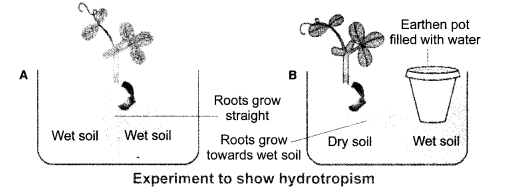
Now, dig up the seedlings carefully from both the troughs without damaging their roots. We will find that the root of seedling in trough A is straight. On the other hand, the root of seedling in trough B is found to be bent to the right side i.e., towards the clay pot containing water.
In trough A, the root of the seedling gets water from both sides. But in trough B, the roots get water oozing out from the clay pot which is kept on the right side. Therefore, the root of seedling in trough B grows and bends towards the source of water to the right side. This experiment shows that the root of a plant grows towards water. In other words, the root of a plant is hydrotropism.
Question 1
How does chemical coordination take place in animals ?
Answer:
Chemical coordination in animals takes place through the hormones secreted by the endocrine glands. Coordination in animals takes place through hormone system as well as nervous system which is called endocrine system. Endocrine glands secrete animal hormones directly into the blood that reach to the specific cells. Special type of molecules are present on the surface of cells to detect these hormones. These cells act according to the information that a particular hormone carries.
Question 2
Why is the use of iodised salt advisable ?
Answer:
It is advised to use iodised salt because thyroid gland needs iodine to produce thyroxin hormone. Thyroxin hormone controls all the metabolic activities of our body like metabolism of carbohydrates, fats and protein etc. Due to the deficiency of thyroxin a disease called goitre is caused.
Question 3
How does our body respond when adrenaline is secreted into the blood ?
Answer:
The heart beat increases when adrenaline is secreted into the blood so that more oxygen is supplied to our muscles. The blood supply to the digestive system and skin decreases because the small arteries around the muscles of these organs contract. This turns the direction of blood towards our skeletal muscles. The breathing rate also increases due to the contractions of the diaphragm and rib muscles. All these responses enable us to face the situations of fear and anger.
Question 4
Why are some patients of diabetes treated by giving injections of insulin ?
Answer:
Insulin hormone regulates blood sugar levels. If this is not secreted in proper amounts, the sugar level in the blood rises. This causes many harmful effects.
To treat harmful effects of increased level of blood sugar, the diabetic patients are treated by giving injections of insulin.
NCERT Solutions for Class 10 Science Chapter 7 Textbook Chapter End Questions
Question 1
Which of the following is a plant hormone?
(a) Insulin
(b) Thyroxin
(c) Oestrogen
(d) Cytokinin
Answer:
(d) Cytokinin
Question 2
The gap between two neurons is called a
(a) dendrite
(b) synapse
(c) axon
(d) impulse
Answer:
(b) Synapse
Question 3
The brain is responsible for
(a) thinking
(b) regulating the heart beat
(c) balancing the body
(d) all of the above
Answer:
(b) All of the above
Question 4
What is the function of receptors in our body ? Think of situations where receptors do not work properly. What problems are likely to arise ? [AICBSE 2016]
Answer:
Receptors are specialised cells located in our sense organs like ear, nose, skin, tongue and eyes. The function of receptors is to detect information from the environment. For example, olfactory receptors detect smell. If receptors do not work properly, the information obtained from the environment will be delayed to reach the spinal cord or brain. In this situation, the response to the environmental stimulus will be delayed causing harm to the body. For example, if skin receptors are damaged, and one accidentally touches a hot object, then his/her hands might get burn as the damaged receptor cannot perceive the external stimuli of heat and pain.
Question 5
Draw the structure of a neuron and explain its function. [AICBSE 2017]
Answer:
Nerve cell or neuron is the functional unit of nervous system. A nerve cell has three parts-
(i) cell body
(ii) dendrite
(iii) axon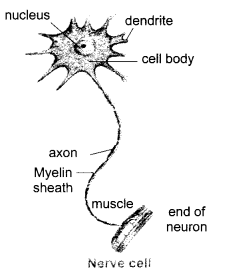
Function : The function of nerve cells is to carry information in the form of electrical signals which are called nerve impulses. Cells receive stimulus to send it to spinal cord and brain and carry the message from brain to the target organ.
Question 6
How does phototropism occur in plants ?
Answer:
The movement in any part of a plant due to light is called phototropism. The shoot of plant shows positive phototropism and roots show negative phototropism.
Phototropism in plants occurs due to the hormone auxin. When light falls on one side of a plant, the secretion of auxin hormone is more in the part away from the light. Hence, auxin causes growth in length of the cells in shady part. So, the plant appears to bend towards light.
Question 7
Which signals will get disrupted in case of a spinal cord injury ?
Answer:
(i) All the involuntary actions will get disturbed.
(ii) Reflex actions will be disturbed because reflexes are located in the spinal cord. Therefore, the quick responses required to safe guard the body will not take place.
Question 8
How does chemical coordination occur in plants ?
Answer:
Chemical coordination in plants takes place with the help of plant hormones. In most of the regions where division takes place (meristematic regions) stimuli cells secrete chemical compounds (hormone). These substances identify the information by stimulating the other nearby cells and communicating the information.
Question 9
What is the need for a system of control and coordination in an organism ?
Answer:
An organism needs control and coordination system for the following functions :
(i) To save the body of the organisms from the harmful changes in the environment.
(ii) To control the speed of voluntary and involuntary actions.
(iii) To have the capability to think and learn for responding to any stimuli.
Question 10
How are involuntary actions and reflex actions different from each other ?
Answer:
| Involuntary actions | Reflex actions |
| 1. Those actions which occur immediately without any thinking are called involuntary actions. | 1. Reflex action is an immediate response to an event which does not require any processing by brain. |
| 2. Involuntary actions are controlled by mid and hind brain. Example: Breathing, beating of heart, etc. | 2. Reflex actions are controlled by spinal cord. Example: Sneezing, coughing, etc. |
Question 11
Compare and contrast nervous and hormonal mechanisms for control and coordination in animals.
Answer:
| Nervous mechanism | Hormonal mechanism |
| It is a fast process. | It is a slow process. |
| Arteries and glands are affected. | It affects the target organ. |
| It transmits in electrochemical form. | It transmits in chemical form. |
| It does not control metabolism. | It controls metabolism. |
| Growth is not affected. | Growth is affected. |
Question 12
What is the difference between the manner in which movement takes place in a sensitive plant and the movement in our legs ?
Answer:
| Movement in a sensitive (mimosa) plant | Movement in legs of a human |
| 1. The leaves of a sensitive plant like mimosa are sensitive to touch. | 1. Leg is in control of nerve muscles. |
| 2. It is not controlled by any part of the plant. | 2. It is controlled by brain and spinal cord. |
| 3. In this, cells change their shape on changing the amount of water in them. | 3. Amount of water has no effect on the movement of muscles. |
| changing the amount of water in them. | the movement of muscles. |
| 4. The movement in a sensitive plant are nastic movement. | 4. The movement in our leg is due to voluntary nervous system. |
Control and Coordination Class 10 HOTS
Question 1.
What type of plant movement is seen in the diagram of coiling of tendril?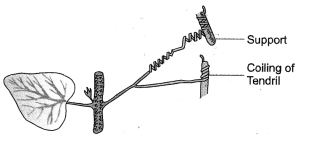
Or
How do auxins promote the growth of a tendril around a support? Describe in brief. (CCE 2012)
Answer:
Thigmotropism or curvature movement that occurs in response to contact. Less auxin is present in the region of contact. The free side having more auxin shows more growth. This causes the tendril to coil over the support.
Question 2.
Identify and label the parts shown as A and B in the accompanying figure.
Answer:
Dorsal view of thyroid an parathyroid.
A – Thyroid,
B- Parathyroid.
Question 3.
What are the hormones involved in providing milk to the suckling infant ?
Answer:
1. Prolactin (Maternity Hormone). Production of milk.
2. Oxytocin Ejection of milk.
Question 4.
How does pancreas control glucose level of blood ?
Answer:
Pancreas produces two hormones
- Insulin from P-cells of islet of Langerhans and
- Glucagon from a- cells of islets of langerhans.
Insulin is produced when glucose level of blood rises. Insulin helps the cells to withdraw glucose from blood. It also converts glucose into glycogen in liver and muscles.
Question 5.
Glucagon is secreted when glucose level of blood falls. It mobilises reserve food like glycogen into glucose. What is pregnancy hormone ? Why is it known so ?
Answer:
Progesterone is called pregnancy hormone. It helps in maintaining pregnancy by non-formation of new ova, promoting thickening and secretory activity of uterine wall and attachment of embryo to the uterine wall.
Question 6.
What is dormin ?
Answer:
Dormin is the other name of plant hormone abscisic acid. The hormne induces dormancy in buds and seeds. So it has been called dormin.
Question 7.
(a)
- Name the parts labelled A and B in the neuron drawn above.
- Which part acquires the information in the neuron ?
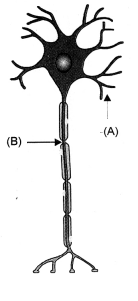
- Through which part does the information travel ?
- In what form does this information travel ?
- Where is the impulse converted into a chemical signal for onward transmission ?
(b) Name the hormone secreted by thyroid. What is the function ?
(c) Why is the use of iodised salt advisable ?
(CBSE A.I. 2008 Compt.)
Answer:
(a)
- A-Dendrite, B-Axon
- Dandrite.
- Dandrite to cell body or cyton to axon.
- Electrical impulse
- In the region of synapse.
Impulse stimulates the release of chemical neurotransmitter from the surface of presynaptic knob or bouton of axon terminal. Neurotransmitter (e.g. acetylcholine) comes in contact with chemoreceptor sites of post-synaptic membrane of the next neuron and generates a fresh impulse.
(b) Thyroxine:
Function of Thyroxine. It controls
- Basal metabolic rate
- Metabalism of carbohydrates, fats and proteins
- Consumption of energy in physical activity and body temperature
- Development and differentiation.
(c) Iodised Salt: Salt is iodised to provide iodine to thyroid for synthesis of thyroxine which is iodine containing hormone.
Question 8.
(a) What are plant hormones ? Give one example each of a plant hormone that
- promotes growth
- inhibits growth.
- promotes cell division
- promotes the growth of a tendril around a support. (CCE 2011)
(b) Name the parts labelled A, B and C in the diagram given below. Write one function of each part. (CBSE A.I. 2008 Comptt. Delhi 2008 Comptt.)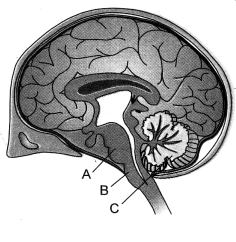
Answer:
(a) Plant Hormones:
Phytohormones are chemical substances other than nutrients produced naturally in plants which regulate growth, development, differentiation and a number of physiological processes, e.g., auxin, gibberellins, abscisic acid, cytokinins.
- Hormone That Promotes Growth. Auxin/Gibberellin.
- Hormone That Inhibits Growth. Abscisic acid or ABA
- Hormone That Promotes Cell Division. Cytokinin.
- Hormone That Promotes Growth of a Tendril Around a Support. Auxin.
(b) A-Pons Function: Relay centre, pneumotaxic area of respiratory centre.
B-Medulla Function: Reflex centre, cardiac centre, respiratory centre.
C-Cerebellum Function: Maintains equilibrium and coordinates muscular activities
Control and Coordination Class 10 Value Based Questions
Question 1.
How do tendrils reach the support when they do not have any sensory structures.
Answer:
Tendrils do not have any sensory structures but still they are able to find their support just as we grope in the dark for finding the switch-board. Tendrils perform circumnutation from their apical regions. In this the terminal parts of tendrils move in all directions. Wherever they come in contact with a support, they stop performing cicumnutation. Instead, the contacted region shows little growth while the other side grows rapidly so that the tendril coils over the support.
Question 2.
Name the nervous system which controls the functioning of internal organs. How does this system work ?
Answer:
Autonomous or visceral nervous system. The system does not consult the will of the individual. It works on its own inputs. Autonomous nervous system consists of only motor nerve fibres that innervate all organs and glands of the body. Depending upon the input, autonomous nervous system stimulates, slows down or stops the activity of an organ. For its working, autonomous or visceral nervous system has two components, sympathetic and parasympathetic. Sympathetic nervous system originates from thoracico-lumbar region, forms two ganglionic chains which send out long nerve fibres to various organs. The sympathetic nerve fibres activate the organs by release of nor-adrenaline. Parasympathetic nervous system is called cranio-sacral as it originates from some cranial and sacral nerves. It has long preganglionic fibres and ganglia attached to organs that are innervated. Its post ganglionic fibres secrete acetylcholine into organs for moderating or reducing their activity.
Question 3.
Which system is working when you start sweating during exercise ? What is its function ?
Answer:
Reflex activity of the nervous system. Actually 90% of nervous activity is performed through reflexes. It is automatic, involuntary and spontaneous response to a stimulus without consulting the will of the individual. Exercise increases body temperature. This can be harmful. Reflex action stimulates the sweat glands for releasing their secretion. Part of the sweat evaporates and cools, down the body.
Question 4.
You can become moody by simply switching on night bulb daily. How can this happen ?
Answer:
Night bulb reduces the secretion of melatonin hormone. Melatonin controls our day-night or circadian rhythm, healthy digestive and immune system, sexual cycle and moods. A reduced secretion causes insomnia and mood changes besides affecting health of our digestive and immune system.
NCERT Solutions for Class 10 Science Chapter 7 Control and Coordination
Control and co-ordination in animals and plants: Tropic movements in plants; Introduction to plant hormones; Control and co-ordination in animals, nervous system; voluntary, involuntary and reflex action; Chemical co-ordination: animal hormones.
| Board | CBSE |
| Textbook | NCERT |
| Class | Class 10 |
| Subject | Science |
| Chapter | Chapter 7 |
| Chapter Name | Control and Coordination |
| Number of Questions Solved | 26 |
| Category | NCERT Solutions |
Formulae Handbook for Class 10 Maths and Science
Question 1
What is the function of receptors in our body?
Solution:
Receptors are usually located in our sense organs, such as the inner ear, the nose, the tongue, and so on. So gustatory receptors will detect taste while olfactory receptors will detect smell.
Question 2
Draw the structure of neuron and explain its function.
Solution: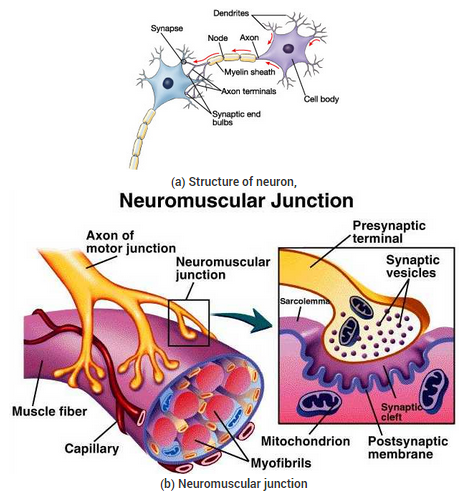
The specialised tips of some nerve cells detect all information from our environment. These receptors are usually located in our sense organs, such as the inner ear, the nose, the tongue, and so on. So gustatory receptors will detect taste while olfactory receptors will detect smell. This information, acquired at the end of the dendritic tip of a nerve cell, sets off a chemical reaction that creates an electrical impulse. This impulse travels from the dendrite to the cell body, and then along the axon to its end. At the end of the axon, the electrical impulse sets off the release of some chemicals. These chemicals cross the gap, or synapse, and start a similar electrical impulse in a dendrite of the next neuron. This is a general scheme of how nervous impulses travel in the body. A similar synapse finally allows delivery of such impulses from neurons to other cells, such as muscles cells or gland. It is thus no surprise that nervous tissue is made up of an organized network of nerve cells or neurons, and is specialised for conducting information via electrical impulses from one part of the body to another.
Question 3
How does phototropism occur in plants?
Solution: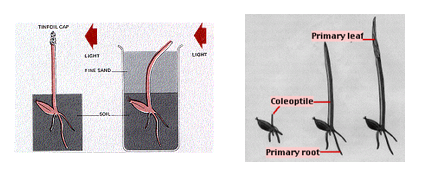
Phototropism is a growth movement induced by a light stimulus. Growth towards a source of light is called positive phototropism, that away from the source is termed negative phototropism. The tips of shoots are usually positively, that of roots negatively phototropic.
Charles Darwin and his son Francis discovered (in 1880) that the phototropic stimulus is detected at the tip of the plant.
The Darwins used grass seedlings for some of their experiments. When grass seeds germinate, the primary leaf pierces the seed coverings and the soil while protected by the coleoptile, a hollow, cylindrical sheath that surrounds it. Once the seedling has grown above the surface, the coleoptile stops growing and the primary leaf pierces it.
The Darwins found that the tip of the coleoptile was necessary for phototropism but that the bending takes place in the region below the tip.
If they placed an opaque cover over the tip, phototropism failed to occur even though the rest of the coleoptile was illuminated from one side.
However, when they buried the plant in fine black sand so that only its tip was exposed, there was no interference with the tropism – the buried coleoptile bent in the direction of the light.
From these experiments, it seemed clear that
- The stimulus (light) was detected at one location (the tip)
- The response (bending) was carried out at another (the region of elongation).
- This implied that the tip was, in some way, communicating with the cells of the region of elongation.
Question 4
How does chemical coordination occur in plants?
Solution:
It has been found that the growth of plants is regulated by certain chemical substances which are synthesized by the plants in very small amounts. These are known as plant hormones or phytohormones.
They are the organic substances which either promote or inhibit growth. A phytohormones can be defined as a chemical substances which are produced naturally in plants and are capable of translocation and regulating one or more physiological processes when present in low concentration. Main categories of plant hormones are:
- Auxins
- Gibberellins
- Cytokinins
- Ethylene
- Abscisic acid
Auxins and Gibberellins stimulate cell elongations, cytokinins stimulate cell division ethylene promotes transverse or isodiametric growth and abscisic acid is a growth inhibitor.
Question 5
What is the need for a system of control and coordination in an organism?
Solution:
Co-ordination in this sense refers to the regulation or control of body activity.
Plants need very little in the way of a control system. Since growth and reproduction are about the only things that are regulated, a rapid control system is not required and hormonal control is all they possess.
Animals are continually moving through new environments that may pose all types of changes and threatening situations to the organism. This requires the rapid and precise control of a nervous system. Hormones regulate slower activities, such as growth, development and reproduction.
Question 6
How are involuntary actions and reflex actions different from each other?
Solution:
All reflex actions are involuntary in nature but all involutary actions are not reflexes as the beating of heart is an involuntary action but is not reflex action.
Reflex actions are very quick but all involutary actions may not be very fast as in heart beating.
A reflex action may involve any muscle or a gland as we withdraw our hand on touching a hot object but all involuntary actions involve only smooth i.e., involuntary or cardiac muscles.
Reflex actions are at the level of spinal cord whereas the involuntary actions generally involve brain too.
Nerves and autonomious nervous system can increase or decrease the rate of involuntary actions but reflex actions can be controlled by great will only and are not usually controllable.
Reflex actions are done to meet emergencies where as an inv.action may or may not be for just meeting an emergency but may be a critical lie process as circulation of blood, swallowing of food, movement of food in food pipe, etc.
Multiple Choice Questions (MCQs) [1 Mark each]
Question 1.
What is the correct direction of flow of electrical impulses ? [NCERT Exemplar]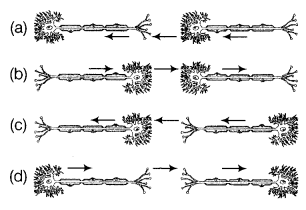
Answer:
(c) Direction of flow of electrical impulse.
Impulse → Dendrite → Cell body → Axon → Release of chemicals that cross synapse → Dendrite of next neuron.
Question 2.
Three directions in which nerve impulses can travel in the nervous system are listed below:
(i) Away from the central nervous system
(ii) Towards the central nervous system
(iii) Within the central nervous system
In which direction do impulses in sensory and relay (intermediate) neurons travel?
| Sensory Neuron | Relay | |
| (a) | (i) | (ii) |
| (b) | (i) | (iii) |
| (c) | (ii) | (i) |
| (d) | (ii) | (iii) |
Answer:
(d) Sensory neuron transmits impulses towards CNS, (i.e. brain and spinal cord) while, the relay neurons occur within the CNS and serve as links between other neurons.
Question 3.
In a nerve pathway, the following events take place in a coordinated order.
(i) Activation of muscle
(ii) Activation of receptor
(iii) Passage of impulses along a motor neuron
(iv) Passage of impulses along a sensory neuron
Read the events given and identify the correct order of these events from the table given below:
| First | → | Last | ||
| (a) | (ii) | (iii) | (iv) | (i) |
| (b) | (ii) | (iv) | (iii) | (i) |
| (c) | (iv) | (i) | (iii) | (ii) |
| (d) | (iv) | (ii) | (i) | (iii) |
Answer:
(b) The sequence of events in a typical nerve pathway is receptor → passage of impulse along sensory neuron → passage of impulse along motor neuron → activation of muscle (effector). Thus, the correct sequence is (ii), (iv), (iii) and (i).
Question 4.
The diagram shows a section of the brain and different parts labelled as W,X, Y and Z.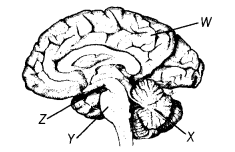
Study the figure and correlate the regions which control balance, heart rate and temperature in human body?
| Balance | Heart Rate | Temperature | |
| (a) | W | Z | X |
| (b) | X | Y | Z |
| (c) | Y | X | W |
| (d) | Z | W | Y |
Answer:
(b) Out of the options given, the region X, (i.e. cerebellum) controls balance, region Y (i.e. medulla oblongata) controls heartbeat and region Z, (i.e. hypothalamus) controls temperature in human body.
Question 5.
Which of the following endocrine glands is unpaired? [NCERT Exemplar]
(a) Adrenal
(b) Testes
(b) Pituitary
(d) Ovary
Answer:
(c) There are two adrenal glands, one on top of each kidney that make adrenaline hormone. Testes are paired glands present in males and secrete male sex hormone. Pituitary gland is present just below the brain and is unpaired. It is also called master gland as it secretes a number of hormones. Ovaries are paired glands present in females and secrete female sex hormones.
Question 6.
Dramatic changes of body features associated with puberty are mainly because of secretion of [NCERT Exemplar]
(a) oestrogen from testes and testosterone from ovary
(b) oestrogen from adrenal gland and testosterone from pituitary gland
(c) testosterone from testes and oestrogen from ovary
(d) testosterone from thyroid gland and oestrogen from pituitary gland
Answer:
(c)
| Gland | Hormone | Function | |
| Testes (only in males) | Testosterone | To control the development of male sex organs and male features such as deep voice, etc., i.e. changes associated with puberty. | |
| Ovaries (only in females) | Oestrogen | To control the development of female sex organs and female features such as soft skin, etc. | |
| Progesterone | To control uterus changes during menstrual cycle and helps in maintenance of pregnancy. | ||
Class 10 Science Control and Coordination Mind Map
Coordination is the process through which two or more organs interact and complement the functions of one another. The neural system & endocrine system jointly coordinate & regulate the physiological functions in the body. The neural system provides an organised network of point-to-point connections for a quick coordination. The endocrine system provides chemical integration through hormones.
Animal Nervous System
The neural system of all animals is composed of highly specialized cells called neurons which can detect, receive & transmit different kinds of stimuli. They are specialized for conducting information via electrical impulses from one part of the body to another.
Structure and Function of Neuron
- It is a structural & functional unit of neural system and is composed of three major parts:
- Ceil body contains cytoplasm with typical cell organelles like nucleus etc.
- Dendrites: Short fibres which branch repeatedly & project out of the cell body. These fibres transmit impulses towards the cell body.
- Axon is a long fibre, the distal end of which is branched and forms nerve ending. Nerve endings possess synaptic vesicles containing chemicals called neurotransmitters.
Transmission of impulses:
- Stimulus or information from the environment is detected by specialized tips of some nerve cells called as receptors.
- Dendritic tip acquire all these information and sets off a chemical reaction.
- This chemical reaction then creates an electric impulse that travels from the dendrite to the cell body, and then along the axon to its end.
- At the end of the axon, the electrical impulse sets off the release of some chemicals (neurotransmitters). These chemicals cross the gap, or synapse, and start a similar electrical impulse in a dendrite of the next neuron.
- A similar synapse finally allows delivery of such impulses from neurons to other cells, such as muscles cells or gland.
The human neural system is divided into two parts:
- Central neural system (CNS) includes the brain & spinal cord and is the site of information processing & control.
- Peripheral neural system (PNS) comprises of all nerves of body associated with CNS (brain and spinal cord). The nerve fibres of PNS are of two types: cranial nerves (arising from the brain) and spinal nerves (arising from the spinal cord).
Brain
- It is the main coordinating centre of the body. The bra in and spinal cord constitute the CNS. They receive information from al 1 parts of the body and integrate it.
- The brain is located in bony box called as cranium or skull which protects the brain. Spinal cord is protected with the help of vertebral column. In addition, cerebrospinal fluid also covers the brain and the spinal cord which provide the function of shock absorption.
- The brain has three such major parts or regions, namely the fore-brain, mid-brain and hind-brain.
- Fore-brain: It is the main thinking part of the brain. It consists of cerebrum, hypothalamus etc.
- Function: interpret information received from sensory receptors.
- Control the movement of voluntary muscles.
- It also contains centre associated with hunger which gives us the sensation of feeling full.
- Midbrain: It serves important function in few involuntary movements, movements of the eye, auditory and visual processing.
- Hindbrain: It consists of pons, medulla, and cerebellum.
- Function: Medulla controls involuntary actions such as blood pressure, salivation and vomiting.
- Cerebellum is responsible for precision of voluntary actions and maintaining the posture and balance of the body.
Reflex Action
- The entire process of response to a peripheral nervous stimulation that occurs involuntarily (without conscious effort or thought) and requires the involvement of a part of central nervous system is called a reflex action.
- Reflex action decreases the duration of action by bypassing the thinking and processing step.
- It does so by linking the nerves carrying the signal (say the sensation of heat) directly to the nerves that move the muscle. These types of linkage or connection between input and output nerves are formed in the spinal cord.
- These connections are called as reflex arc (sensory/input nerve-* Spinal cord -> motor/ output nerve)
Coordination In Plants
Plants have neither nervous system nor muscles. Their movements or responses are either growth dependent or growth independent.
Immediate Response To Stimulus Or Growth Independent
The plants also use electrical-chemical means to convey information from cell to cell, but unlike in animals, there is no specialised tissue in plants for the conduction of information.
Secondly, plant cells change shape by changing the amount of water in them, resulting in swelling or shrinking. In contrast, animal muscle cells have special proteins that change both their shape and their arrangement in the cell in response to nervous electrical impulses.
Example: folding up and drooping of leaves of chhui-mui (the ‘sensitive’ or ‘touch-me-not’ plant of the Mimosa family) in response to touch.
Movement Due To Growth
The movement of a plant in response to the stimulus is called as tropism. The movement in the direction of the response is called as positive tropism and movement away from the stimulus is termed as negative tropism.
Types:
- Phototropism: Bending of plant in response to the light e.g. movement of sunflowers in response to day or night.
- Geotropism: Movement of plant in response to gravity. Shoots show negative geotropism and roots show positive geotropism.
- Chemotropism: Movement of plant in response to chemical as observed in case of growth of pollen tube.
- Hydrotropism: e.g. roots beneath the Earth’s surface bend in the direction of underground w^ater.
Other example may include the climbing of tendrils in response to touch. When they come in contact with any support, the part of the tendril in contact with the object does not grow as rapidly as the part of the tendril away from the object. This causes the tendril to circle around the object and thus cling to it.
Plant Hormones
There are five main types of plant hormones or growth regulators:
- Auxins: Helps in cell elongation and thus phototropism, geotropism, and other plant responses.
- Gibberellins: Stimulate growth of the stem and flowering.
- Cytokinins: They cause cell division, enlargement, and organ formation. They are present in greater concentration in areas of rapid cell division, such as in fruits and seeds.
- Ethylene: Promotes ripening of fruits.
- Abscisic acid: Inhibits growth and causes wilting of leaves and fruits.
Hormones In Animals
Hormones are non-nutrient chemicals which act as intercellular messengers & are produced in trace amounts. The timing and amount of hormone released are regulated by feedback mechanisms Examples:
- Adrenaline: Secreted from adrenal gland which prepare the body for fight or flight situation.
- Thyroxin: Secreted from thyroid gland and regulates carbohydrate, protein and fat metabolism so as to provide the best balance for growth.
Deficiency of iodine in diet may cause hypo-secretion of thyroxin which results in goiter. - Growth hormones which regulate growth and. development of the body are secreted from
pituitary gland.
Hyper-secretion may cause gigantism and hypo-secretion may cause dwarfism. - Testosterone in males and oestrogen in females lead to changes take place during puberty’.
- Insulin produced by pancreas regulates the blood sugar level in the body.
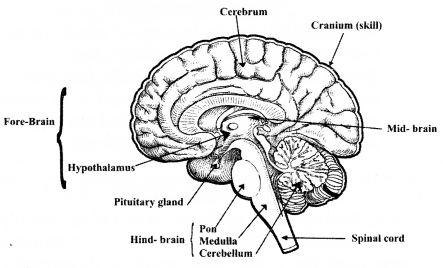
NCERT Solutions for Class 10 Science Chapter 7 Control and Coordination (Hindi Medium)
उत्तर प्रदेश, मध्य प्रदेश, and गुजरात में भी NCERT की किताबें लगने के बाद हम लोग UP बोर्ड, MP बोर्ड, Gujrat Board के लिए भी अध्धयन सामग्री बना रहे हैं। अगर UP Board NCERT Solutions प्राप्त करने में विद्यार्थियों को किसी प्रकार की परेशानी हो रही है तो हमें Contact करें UP Board Secondary Education (High School) के लिए अध्ययन सामग्री, Sample Papers, Notes तथा पश्नों के हल यहाँ से प्राप्त करें।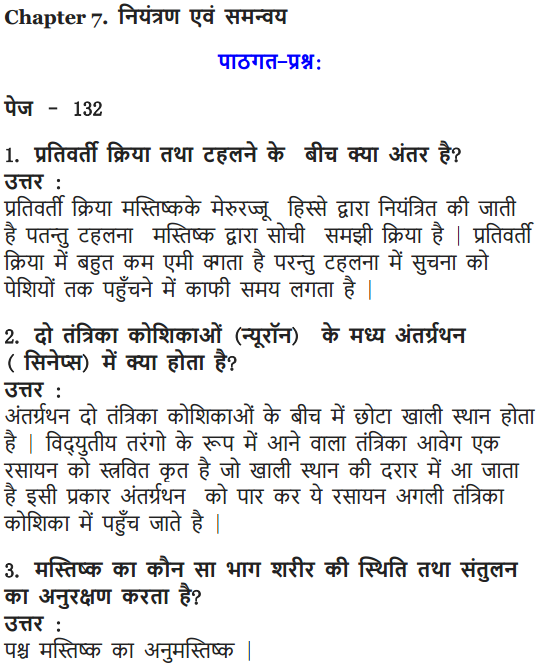
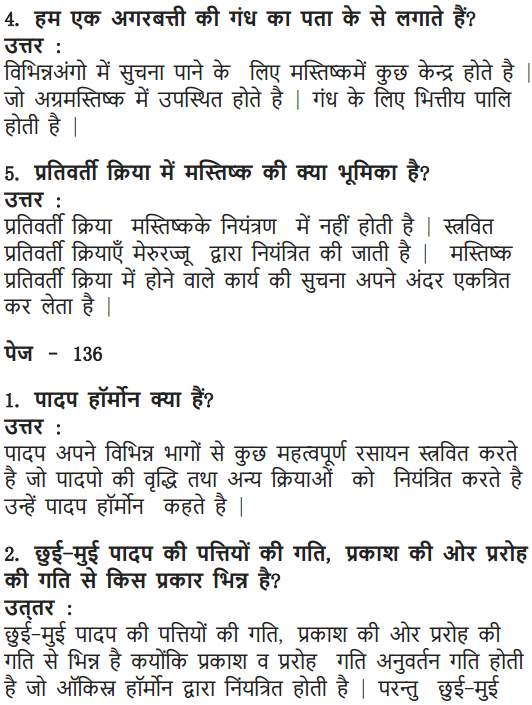
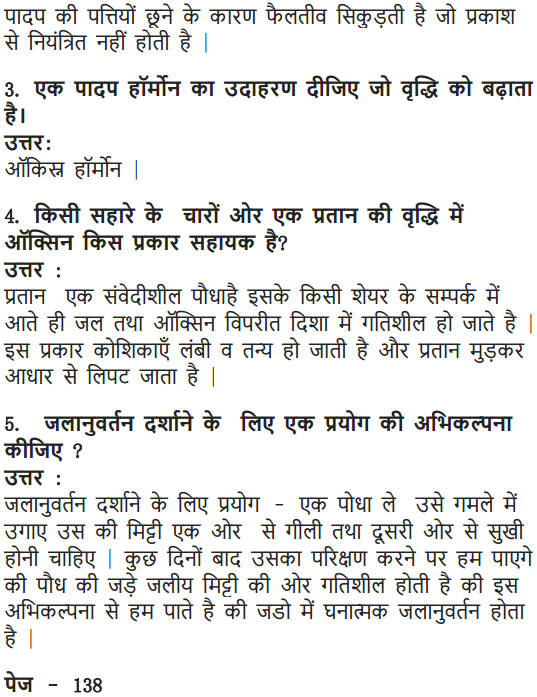
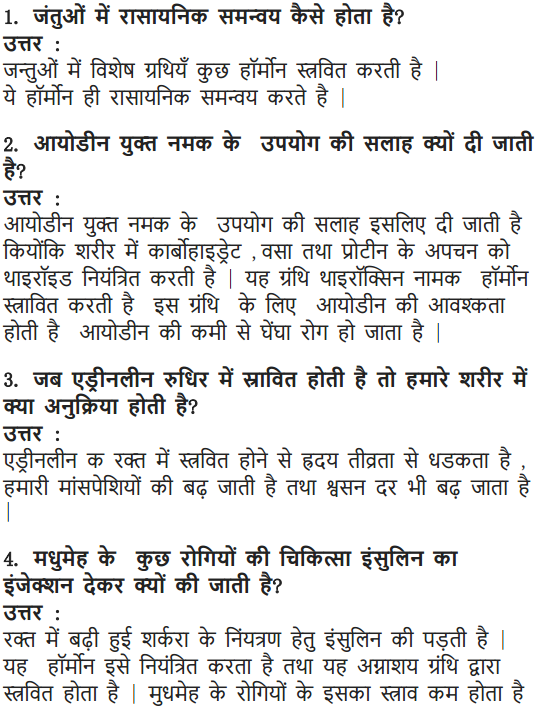
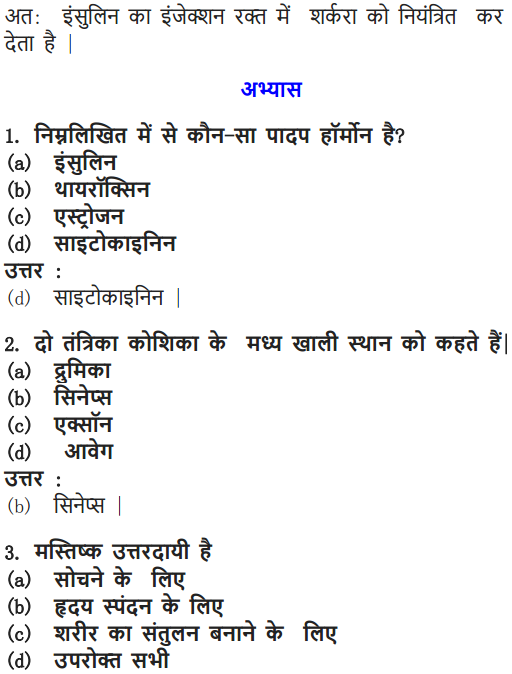
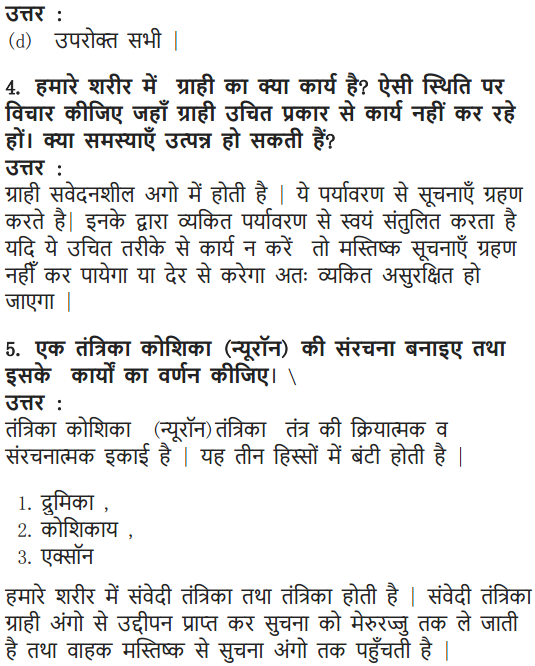

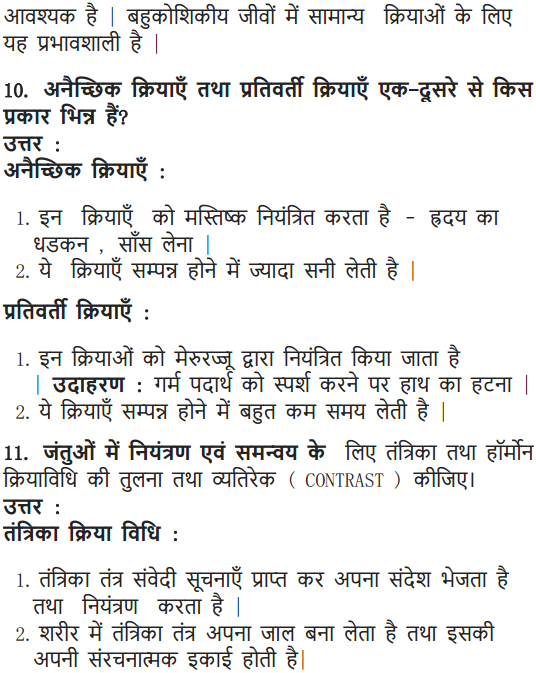
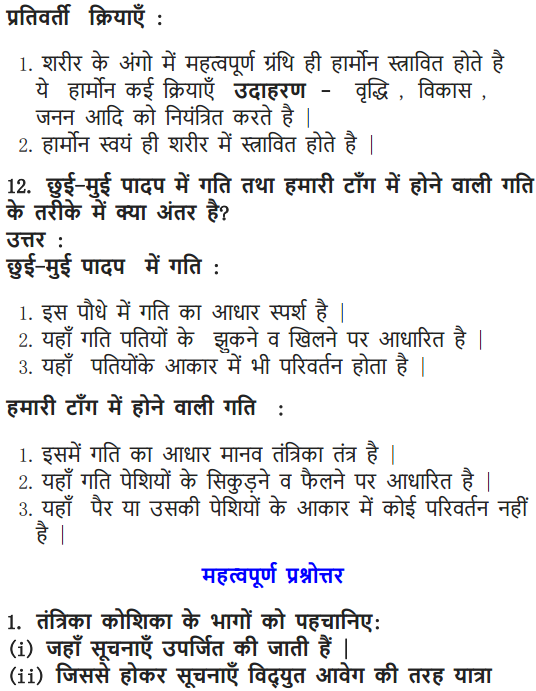
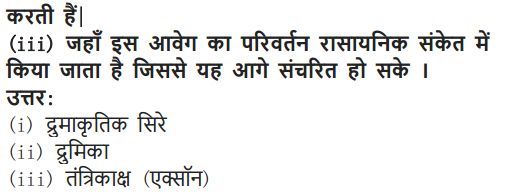
Now you are provided all the necessary information regarding control and coordination class 10 NCERT questions and we hope this detailed article on NCERT Solutions For Class 10 Science Chapter 7 Control And Coordination is helpful. If you have any question or doubt related to this article, drop your comments in the comment box below and we will get back to you as soon as possible.
Important Questions of Control and Coordination Class 10 Science Chapter 7
Question 1.
Which is the largest and most prominent part of the brain? (Board Term I, 2013)
Answer:
Cerebrum is the largest and most prominent part of the brain.
Question 2.
(a) Name one gustatory receptor and one olfactory receptor in human beings.
(b) Write a and b in the given flow chart of neuron through which information travels as an electrical impulse.
Answer:
(a) Gustatory receptors are receptors for taste present in taste buds on tongue and olfactory receptors are the receptors for smell present in nasal chambers.
In the given flow chart, a is cyton and b is axon.
Question 3.
Write the main functions of the following :
(a) sensory neuron
(b) cranium
(c) vertebral column
(d) motor neuron. (Board Term I, 2017)
Answer:
(a) Sensory neuron occur in sense organs and receive stimuli through their dendrites. The sensory neurons transmit impulses towards the central nervous system (brain and spinal cord) with the help of their axons.
(b) Cranium : The bones of cranium or brain box protect the brain from mechanical injury.
(c) Vertebral column : Major function of the vertebral column is protection of the spinal cord and carries the weight of the upper body.
(d) Motor neuron: The dendrites of these neurons synapse with axons of interneurons in central nervous system. They transmit impulses from central nervous system towards effectors (muscles or glands). The latter respond to stimuli.
Question 4.
Why does the flow of signals in a synapse from axonal end of one neuron to dendritic end of another neuron take place but not in the reverse direction? Explain. (AI 2019)
Answer:
At the synapse, (functional junction between neurons) axon terminal comes in close proximity to the dendron terminal of next neuron. Axon terminal is expanded to form pre-synaptic knob and the other dendrite terminal forms post- synaptic depression.
In between the two, lies a narrow fluid filled space called synaptic cleft. As the nerve impulse reaches the pre-synaptic knob, the synaptic vesicles get stimulated to release neurotransmitter in the synaptic cleft. The neurotransmitter molecules diffuse across the gap to come in contact with post-synaptic membrane. In this way, nerve impulse passes across the minute gap to stimulate dendron of other neuron. The synapse acts as a one-way valve to conduct impulse in one direction only. This is so because chemical substance called neurotransmitter is secreted only on one side of the gap, i.e., on axon’s side. It carries impulse across the synapse and passes it to the dendron of the other neuron. In this way, impulses travel across the neurons only in one direction, i.e., from axon of one neuron to dendron of other neuron through a synapse.
Question 5.
“Reflex arcs continue to be more efficient for quick responses”. Justify this statement giving reason. (Board Term I, 2017)
Answer:
Reflex action is an automatic and spontaneous response to a stimulus. The pathway taken by nerve impulses and responses in a reflex action is called a reflex arc. It consists of receptor, sensory nerve (afferent), spinal cord, motor nerve (efferent) and effector (muscles or glands). Reflex arc is evolved in animals because the thinking process of the brain is not fast enough. Reflex arc enables the body to give quick responses to harmful stimuli so that chances of damage to body are decreased. It also prevents overloading of brain, so prevents its fatigue. Many animals have very little or none of the complex neuron network needed for thinking. So, it is likely that reflex arc has evolved as an efficient way of functioning in the absence of true thought processes. However, even after complex neuron networks have came into existence, reflex arcs continue to be more efficient for quick responses.
Question 6.
(a) Define reflex arc.
(b) Trace the sequence of events which occur in our body when a bright light is focussed on your eyes. (Board Term I, 2016)
Answer:
(a) The pathway taken by the nerve impulses in a reflex action, from receptor organ to spinal cord and back to effector organ of reflex action is called reflex arc. Receptor organ could be a sense organ such as eyes, skin, etc., and effector organ could be muscles, glands, etc.
(b) When a bright light is focussed on eye, receptor cell receives the stimulus and an impulse is generated. This impulse is passed on to sensory neuron, then it goes to brain, brain sends the impulse to the motor neuron which contracts the pupil. Sequence of events can be summarised as : Photoreceptors in eye → Sensory (Receptor) neuron → Brain → Motor (Effector) neuron → Eye muscle → Constriction of pupils
Question 7.
(a) Draw a neat diagram of a neuron and label (i) dendrite and (ii) axon.
(b) Which part of the human brain is:
(i) the main thinking part of the brain?
(ii) responsible for maintaining the posture and balance of the body? (Board Term I, 2015)
Answer:
(a) Diagrammatic representation of a neuron is as follows: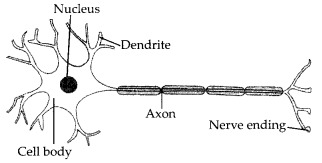
(b) (i) Forebrain which includes cerebrum, olfactory lobes and diencephalon, is the main thinking part of the brain.
(ii) Cerebellum, part of hindbrain is responsible for maintaining the posture and balance of the body.
Question 8.
Mentioh three major regions of brain. Write one function of each. (Board Term I, 2014)
Answer:
Brain is divided into three main regions forebrain, midbrain and hindbrain.
(i) Forebrain consists of cerebrum, olfactory lobes and diencephalon. Its main function is thinking and controlling various activities such as touch, smell, hearing, speech and sight.
(ii) Midbrain controls reflex movements of the head, neck and trunk in response to visual and auditory stimuli.
(iii) Hindbrain has three centres called pons, cerebellum and medulla. This part is responsible for regulating respiration, maintaining posture and balance of body and controlling involuntary actions such as heartbeat, breathing, swallowing, coughing, sneezing, vomiting, etc.
Question 9.
State one example of chemotropism. (Board Term I, 2015)
Answer:
Growth of pollen tube towards the ovule due to chemical stimulus during the process of fertilisation in a flower is an example of chemotropism.
Question 10.
What is meant by tropic movements? (Board Term I, 2013)
Answer:
Directional movements or orientations of specific part of a plant in response to external stimuli are called tropisms or tropic movements.
Question 11.
State the two types of movements seen in plants. Give one example of each type. (Board Term I, 2016)
Answer:
Two types of movements seen in plants are:
(i) Nastic movements are movements independent of growth that are non-direclional and occur due to turgor changes, e.g., closing of leaves in response to touch stimulus in ‘touch me not’ plant.
(ii) Tropic movements or tropism are movements due to growth, that are directional and very slow, e.g., movement of a part of the plant in response to light.
Question 12.
Define geotropism. Draw a labelled diagram of a plant showing geotropic movement of its parts. (2020)
Answer:
Geotropism refers to the upward and downward growth of shoots and roots respectively in response to the pull of earth or gravity. If the plant part moves in the direction of gravity, it is called positive geotropism. Likewise, if the plant part moves against the direction of gravity, it is termed as negative geotropism. Shoots are usually negatively geotropic and roots are usually positively geotropic. A well labelled diagram of plant showing geotropism is: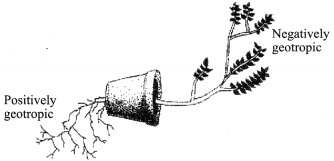
Question 13.
What are plant hormones? Name the plant hormones responsible for the following :
(i) Growth of stem
(ii) Promotion of cell division
(iii) Inhibition of growth
(iv) Elongation of cells (Delhi 2019)
Answer:
Plant hormones or phytohormones are chemical substances produced naturally in plants and capable of translocation and regulating one or more physiological processes when present in low concentration. These are also known as plant growth substances or plant growth regulators.
The plant hormones responsible for different functions are as follows:
(i) Growth of stem : Gibberellins (Gibberellic acid) promote growth in stems.
(ii) Promotion of cell division : Cytokinins promote cell division in plants.
(iii) Inhibition of growth : ABA (Abscisic acid) promotes dormancy in seeds as well as in buds and thus inhibits growth.
(iv) Elongation of cells : Auxin and cytokinin both cause cell elongation.
Question 14.
Define phototropism. Name the plant hormone which is responsible for phototropism. (Board Term I, 2016)
Answer:
Phototropism is the movement of a part of the plant in response to light. Shoots generally grow towards light and are said to be positively phototropic, while roots grow away from light and are said to be negatively phototropic.
The growth movement of the plant part (stem) is caused by the action of auxin hormone. Auxin causes cell elongation. Thus, causing growth of stem towards the light stimulus.
Question 15.
(a) What are phytohormones? List four types of phytohormones. Where are these hormones synthesised?
(b) What happens when a growing plant detects light? Explain in brief. (Board Term I, 2017)
Answer:
(a) Phytohormones are chemical substances produced naturally in plants and are capable of translocation and regulating one or more physiological processes when present in low concentration. Plant hormones help to coordinate growth, development and responses to the environment. Plant hormones are also known as plant growth substances or plant growth regulators.
Types of hormone and their site of synthesis are as follows:
| Plant hormone | Site of Synthesis |
| (i) Auxin | Auxin hormone is synthesised by the meristematic tissue at the tip of the stem and roots. |
| (ii) Gibberellins (Gibberellic acid) | Gibberellins are synthesised in young leaves, roots and shoots and transported to other parts of the plant. |
| (iii) Cytokinin | It is synthesised in roots and transported to shoot region through xylem. |
| (iv) Ethylene | It is formed in almost all plant parts – roots, leaves flowers, fruits, seeds, etc. |
| (v) Abscisic acid | It is produced in many parts of the plant but more abundantly inside the chloroplast of green cells. |
(b) Plants respond to light by showing growth movement towards light (phototropism). This growth movement of the plant part (stem) is caused by the action of auxin hormone. The auxin hormone is synthesised in the meristematic tissue at the tip of the stem. Auxin diffuses uniformly down the stem in plants that are kept in the open and receive sunlight from above. Due to presence of auxin equally on both the sides, the stem grows up straight because both the sides of the stem show growth at the same place. But when sunlight is unidirectional, auxin- gets accumulated towards the shady region of (he shoot. This causes the cells to elongate and stem to bend towards light.
Question 16.
List the sequences of events that occur when a plant is exposed to unidirectional light, leading to bending of a growing shoot. Also name the hormone synthesised and the type of movement that takes place. (Board Term I, 2016)
Answer:
Refer to answer 15 (b).
Question 17.
(a) Define reflex arc. Draw a flow chart showing the sequence of events which occur during sneezing.
(b) List four plant hormones. Write one function of each. (Board Term I, 2014)
Answer:
(a) Reflex arc is defined as the pathway or route taken by nerve impulses in a reflex action. Sequences of events that occur during sneezing can be depicted as :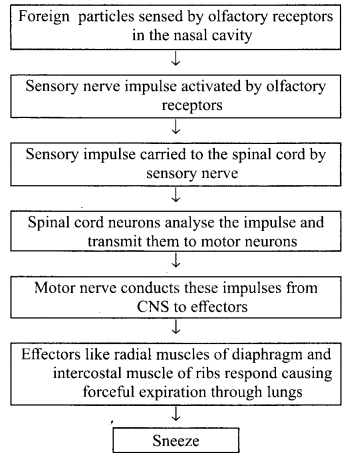
(b) Four plant hormones are:
(i) Auxins : These promote cell enlargement and cell differentiation in plants. These also promote stem and fruit growth.
(ii) Gibberellins : These promote cell enlargement and cell differentiation in plants in the presence of auxins. These also promote growth in stems and fruits.
(iii) Cytokinins : These promote cell division in plants. These play vital role in the morphogenesis in plants.
(iv) Ethylene : It promotes growth and ripening of fruits. It helps in breaking the dormancy in buds and seeds.
Answer question numbers 18 to 21 on the basis of your understanding of the following information and related studied concepts :
Thyroid gland is a bilobed structure situated in our neck region. It secretes a hormone called thyroxine. Iodine is necessary for the thyroid gland to make thyroxine. Thyroxine regulates carbohydrates, protein and fat metabolism in the body. It promotes growth of body tissues also. When there is an excess of thyroxine in the body, a person suffers from hyperthyroidism and if this gland is underactive it results in hypothyroidism. Hyperthyroidism is diagnosed by blood tests that measure the levels of thyroxine and Thyroid Stimulating Hormone (TSH). Hypothyroidism is caused due to the deficiency of iodine in our diet resulting in a disease called goitre. Iod;sed salt can be included in our diet to control it.
Question 18.
Where is thyroid gland situated?
Answer:
Thyroid gland is situated in our neck region.
Question 19.
State the function of thyroxine in human body.
Answer:
Thyroxine regulates carbohydrate, protein and fat metabolism in the body. It promotes growth of body tissues also.
Question 20.
What is hyperthyroidism?
Answer:
Hyperthyroidism occurs when there is excess of thyroxine in the body.
Question 21.
How can we control hypothyroidism? (2020)
Answer:
Hypothyroidism can be controlled by using iodised salt.
Question numbers 22 to 25 are based on table given below. Study the table in which the levels of Thyroid Stimulating Hormone (TSH) in women are given and answer the questions that follow on the basis of understanding of the following paragraph and the related studied concepts :
| Age Range | Normal (mU/L) | Low (mU/L) |
| 18-29 years | 0.4-2.34 mU/L | < 0.4 mU/L |
| 30-49 years | 0.4-4.0 mU/L | < 0.4 mU/L |
| 50-79 years | 0.46-4.68 mU/L | < 0.46 mU/L |
Women are at greater risk for developing abnormal TSH levels during menstruation, while giving birth and after going through menopause. Around 5% of women in the United States have some kind of thyroid problem compared to 3% of men. Despite claims that high TSH increases your risk for heart disease, a 2013 study found no link between high TSH and heart diseases. But a 2017 study showed that older women are especially at risk for developing thyroid cancer if they have high TSH levels along with thyroid nodules.
Question 22.
A 35 years old woman has TSH level 6.03 mU/L. What change should she bring in her diet to control this level?
Answer:
(a) A 35 year old woman with TSH level 6.03 mU/L means she is suffering hypothyroidism. Iodised salt can be included in her diet to control it.
Question 23.
When do women face a greater risk of abnormal TSH level?
Answer:
Women are at greater risk for developing abnormal TSH levels during menstruation, while giving birth and after going through menopause.
Question 24.
State the consequence of low TSH level.
Answer:
The low TSH level means that there is an excess of thyroxine (hyperthyroidism) in the body secreted by thyroid gland. So, the pituitary gland starts producing less TSH.
Question 25.
Name the mineral that is responsible for synthesis of hormone secreted by thyroid gland. (2020)
Answer:
Thyroid gland makes a hormone called thyroxine, which contains iodine.
Question numbers 26 to 29 are based on the table and related information in the passage given below: Thyroid Stimulating Hormone (TSH) stimulates thyroid gland to produce thyroxine. Study the table given below.
Table : TSH levels during pregnancy
| Stage of pregnancy | Normal (mU/L) | Low (mU/L) | High (mU/L) |
| First trimester | 0.2-2.5 | <0.2 | 2.5 – 10 |
| Second trimester | 0.3-3.0 | <0.3 | 3.01 |
| Third trimester | 0.8-5.2 | <0.8 | > 5.3 |
It is important to monitor TSH levels during pregnancy. High TSH levels and hypothyroidism can especially affect chances of miscarriage. Therefore, proper medication in consultation with a doctor is required to regulate/control the proper functioning of the thyroid gland.
Question 26.
Give the full form of TSH.
Answer:
The full form of TSH is Thyroid Stimulating Hormone.
Question 27.
State the main function of TSH.
Answer:
TSH stimulates thyroid gland to produce thyroxine.
Question 28.
Why do TSH levels in pregnant women need to be monitored?
Answer:
TSH levels in pregnant women need to be monitored as high TSH levels and hypothyroidism can increase chances of miscarriage.
Question 29.
A pregnant woman has TSH level of 8.95 mU/L. What care is needed for her? (2020)
Answer:
A pregnant women with high TSH level needs proper medication in consultation with a doctor to control the proper functioning of thyroid gland.
Question 30.
A squirrel is in a scary situation. Its body has to prepare for either fighting or running away. State the immediate changes that take place in its body so that the squirrel is able to either fight or run. (2020)
Answer:
When squirrel is in a scary situation then its nervous system stimulates the adrenal glands to secrete more adrenaline hormone into blood.
This adrenaline hormone increases heartbeat, breathing rate, blood flow into muscles and causes liver to put more stored glucose into its blood. All these actions of adrenaline hormone produces a lot of energy in squirrel’s body. In this way, squirrel prepares itself for fighting or running away action.
Question 31.
Why is chemical communication better than electrical impulses as a means of communication between cells in a multicellular organisms? (2020)
Answer:
In animals, the message communicated in the form of nerve impulses, from receptors to central nervous system and from latter to effectors is very quick. But nerve impulses can reach only those animal cells which are connected by the nervous tissue. These cells after generation and transmission of nerve impulses, take sometime to reset their mechanism before a new impulse is generated and transmitted. It means, cells cannot continuously generate and transmit electrical impulses. This is the reason most multicellular organisms use another means of communication called chemical communication. In chemical communication information spreads out throughout the body by blood and its effects lasts longer. Chemical communication is however slow but it can reach all the cells of body regardless of nervous connections.
Question 32.
A cheetah, on seeing a prey moves towards him at a very high speed. What causes the movement of his muscles? How does the chemistry of cellular components of muscles change during this event? (2020)
Answer:
The cheetah senses its prey by photoreceptors and the information is sent to the central nervous system. The response is then carried by neurons. Along with nervous system, the hormonal system also plays a role. Adrenaline hormone produced by the adrenal glands triggers the flight or fight action. On seeing a prey, these hormones are released into the cheetahs blood stream. It speeds up heartbeat, breathing increases blood flow into leg muscles and causes liver to put more stored glucose into cheetahs blood. All these actions of adrenline hormone produces a lot of energy which helps cheetah to run fast.
Question 33.
Name the hormones secreted by the following endocrine glands and specify one function of each: (a) Thyroid (b) Pituitary (c) Pancreas. (2018)
Answer:
(a) Thyroid gland secrete three hormones : thyroxine (T4), triiodothyroxine (T3) and calcitionin. Thyroxine and triiodothyronine maintain the basal metabolic rate (BMR) of the body by regulating the rate of oxidation of carbohydrates, fats and proteins and production of energy in our body. They promote growth of body tissues and development of mental faculties.
Calcitonin regulate the concentration of calcium and phosphorus in the blood.
(b) Pituitary secretes following hormones :
- Growth hormone (GH) or somatotropic hormone controls the overall development of body, muscles, bones and tissues.
- Thyroid stimulating hormone (TSH) controls growth and functions of thyroid gland.
- Adrenocorticotropic hormone (ACTH) stimulates adrenal cortex to secrete cortisol hormone.
- Follicle stimulating hormone (FSH) in males, stimulates sperm formation and in females, development of follicle cells into mature eggs.
- Luteinising hormone (LH) stimulates secretion of testosterone in males and estrogen and progesterone in females.
- Prolactin hormone (PRL) responsible for growth of mammary glands and milk production in females.
- Melanocyte stimulating hormone (MSH) stimulates the synthesis of melanocytes.
- Oxytocin stimulates lactation after child birth.
- Vasopressin regulates water balance in body fluids.
(c) Pancreas secretes following hormones :
(i) Insulin regulates the conversion of glucose to glycogen, i.e., it lowers the blood glucose level.
(ii) Glucagon is responsible for regulation of glycogen to glucose, i.e., increase blood glucose level.
Question 34.
(a) How does chemical coordination take place in animals?
(b) It is advised to use iodised salt. Give reason. (Board Term 1, 2017)
Answer:
(a) The endocrine system consists of specialised glands (endocrine glands) which brings about control by sending chemical messengers termed hormones. These glands secrete hormones directly into the blood. Flormones reach the target organs via blood and regulate the activities of these organs, thus coordinating the functioning of living organisms and also their growth.
(b) Iodine is necessary for the making of thyroxine hormone by thyroid gland. Therefore, deficiency of iodine in the diet can cause deficiency of thyroxine hormone in the body.
Question 35.
(a) An old man is advised by his doctor to take less sugar in his diet. Name the disease from which the man is suffering. Mention the hormone due to imbalance of which he is suffering from this disease. Which endocrine gland secretes this hormone?
(b) Name the endocrine gland which secretes growth hormone. What will be the effect of the following on a person
(i) deficiency of growth hormone
(ii) excess secretion of growth hormone? (Board Term I, 2016)
Answer:
(a) Old man who is advised by his doctor to take less sugar in his diet is suffering from diabetes mellitus that occurs due to imbalance of insulin hormone. Endocrine part of islets of Langerhans in pancreas secrete insulin hormone.
(b) Growth hormone (GH) or somatotropic hormone (SH) is secreted by pituitary gland.
Effect of the following on a person:
(i) Deficiency of growth hormone (hypoactivity) causes dwarfness.
(ii) Excess secretion of growth hormone (hyperactivity) causes excessive growth of bones making the person very tall (gigantism).
Question 36.
Name the hormone required for the following. Also mention the name of endocrine gland from which that hormone is secreted:
(a) Lowering of blood glucose.
(b) Development of moustache and beard in human males.
(c) Metabolism of carbohydrates, fats and proteins. (Board Term I, 2015)
Answer:
(a) The hormone that lowers blood sugar level is insulin. The function of insulin hormone is to lower the blood sugar level (or blood glucose level, i.e., it controls the metabolism of sugar. It is secreted by the endocrine part of pancreas called islets of Langerhans.
(b) Testes secretes the male sex hormone called testosterone, which is responsible for development of male sex organs and male features such as deeper voice, moustache, beard and body hair.
(c) Thyroxine hormone is synthesised by thyroid gland. Thyroxine controls the rate of metabolism of carbohydrates, fats and proteins.
Question 37.
(a) Complete the following table:
| Name of the hormone | Gland which secretes the hormone | Functions of the hormone |
| (i) Thyroxine | Thyroid | ——— |
| (ii) Growth Hormone | —– | Regulates growth and development of the body |
| (iii) Insulin | Pancreas | ——— |
(b) List three characteristics of animal hormones. (Board Term I, 2015)
Answer:
(a) (i) Functions of thyroxine hormone is regulation of carbohydrates, protein and fat metabolism.
(ii) Gland that secretes growth hormone is pituitary gland.
(iii) Function of insulin is to regulate the conversion of glucose to glycogen, i.e., it lowers blood glucose level.
(b) Three characteristics of animal hormones are:
(i) Hormones are synthesised by endocrine glands and secreted directly into the blood stream.
(ii) They are produced at a place other than the site of action. They travel through blood and have specific action on a specific target organ.
(iii) Chemically the hormones may be peptides, proteins, amines or steroids.
Question 38.
List in tabular form three differences between nervous control and chemical control. (Board Term I, 2013)
Answer:
Differences between nervous control and chemical control are as follows:
| Nervous control | Chemical control |
| (i) Information travels rapidly in a fraction of second. | Information travels slowly. |
| (ii) Information is sent as an electrical impulse along axon and as a chemical across synapse. | Information is sent as a chemical messenger called hormone, via blood stream. |
| (iii) Information is directed to specific receptors which can be one or a few nerve fibres, gland cells or other neurons. | Information is spread throughout the body by blood from which the target cells or organs pick it up. |
| (iv) Effect of message usually lasts for a very short while. | Effect of message usually lasts longer. |
Question 39.
A gland secretes a particular hormone. The deficiency of this hormone in the body causes a particular disease in which the blood sugar level rises.
(i) Name the gland and the hormone secreted by it.
(ii) Mention the role played by this hormone.
(iii) Name the disease caused due to deficiency of this hormone. (Board Term I, 2013)
Answer:
(i) Pancreas secretes insulin hormone.
(ii) Insulin regulates the conversion of glucose to glycogen, i.e., it lowers blood glucose level.
(iii) Deficiency of insulin hormone causes diabetes mellitus.
Question 40.
(a) Name one organ each where growth hormone is synthesised in man and plant.
(b) List the sequence of events that occur when a plant is exposed to unidirectional light, leading to bending of a growing shoot. Also name the hormone and the type of movement. (Board Term I, 2014)
Answer:
(a) In man, growth hormone is synthesised by pituitary gland which is present below the brain. Growth hormone controls the growth of human body.
In plants, auxins promote the plant growth. Auxins are produced by growing apices of the stems and roots. They migrate to the regions of their action, and initiate cell division and cell elongation.
(b) (i) When a plant is exposed to unidirectional light, the shoot tips synthesise phytohormone called auxin.
(ii) Auxins slowly diffuse towards the shady side.
(iii) As auxins help the plant to grow, cells on the shady side grow longer than the ones which are exposed to light.
(iv) Hence, causing the plant to bend towards light. This type of movement caused due to hormone auxin is called phototropism.
Shoots generally grow towards the light hence show positive phototropism and roots grow away from light and show negative phototropism.
Very Snort Answer Type Question [1 Mark] -Year 2015
41.Why is it advised to use iodised salt in our diet ?
Answer. Iodine stimulates the thyroid gland to produce thyroxin hormone. Deficiency of this hormone results in the enlargement of the thyroid gland. This can lead to goitre.
Short Answer Type Questions[ll] [3 Marks] -Year 2015
42.State how concentration of auxin stimulates the cells to grow longer on the side of the shoot which is away from light ?
Answer. When light falls on the side of the shoot auxin diffuses towards the shady side of the shoot. This concentration of the auxin stimulates the cell to grow longer on the side of the shoot which is away from light. Thus plant appears to bend towards light.
43. What is synapse ? In a neuron cell how is an electrical impulse created and what is the role of synapse in this context ?
Answer. A synapse is the gap between the two neurons. Here the axon terminal of one neuron is in close proximity to the dendrite of the second neuron. When a nerve impulse reaches the knob like nerve ending of an axon, a tiny amount of a chemical substance is released in the synapse. This chemical substance is called as the neurotransmitter. At synapse the electrical signals converted into chemicals, that can easily cross over the gap and pass on to the next neurons where it again converted into electrical signals.
Very Short Answer Type Question [1 Mark]- Year 2014
44. Give an example of a plant hormone that promotes its growth. Where it is synthesized ?
Answer. Plant hormone that promotes growth is auxin. It is synthesized at the tip of the plant stem.
Short Answer Type Question [I] [2 Marks] – Year 2014
45.(i) Name the hormones that are released in human males and females when they reach puberty.
(ii) Name a gland associated with brain. Which problem is caused due to the deficiency of the hormone released by this gland ?
Answer.
(i) Testes in males produces hormone testosterone.
Ovaries in females produces hormone oestrogen.
(ii)Pituitary gland present in the brain is responsible for body growth, development of bones and muscles (if excess-gigantism) (if less-dwarfism).
Short Answer Type Questions[ll] [3 Marks] – Year 2014
46.Write one example each of the following tropic movements :
(i) Positive phototropism (ii) Negative phototropism
(iii) Positive geotropism (iv) Negative geotropism
(v) Hydrotropism (vi) Chemotropism
Answer.
(i) Positive phototropism: shoots growing towards light.
(ii)Negative phototropism: roots growing away from light towards ground.
(iii) Positive geotropism: growth of roots towards earth due to the pull of the earth.
(iv)Negative geotropism: shoots growing away from the earth.
(v) Hydrotropism: roots growing towards the source of water.
(vi)Chemotropism: growth of pollen tubes towards the ovules.
Long Answer Type Questions [5 Marks] – Year 2014
47.(a) Name the hormone which is released into the blood when its sugar level rises. Explain the need of Chemical communication in multicellular organisms the organ which produces this hormone and its effect on blood sugar level. Also mention the digestive enzymes secreted by this organ with one function of each.
(b) Explain the need of Chemical communication in multicellular organisms.
Answer.
(a) Glucose is needed by cells for respiration. It is important that the concentration of glucose in the blood is maintained at a constant level. Insulin is a hormone produced by the a-cells that regulates glucose levels in the blood.
In order for multicellular organisms to function properly, their cells must communicate. For instance, your muscles must contract when your brain sends a message to contract.
Pancreas produces insulin and p-cells which increase glucose in blood. It also – produces digestive enzyme (pancreatic amylase).
(b) Cell-to-cell signaling is a critical component of coordinating cellular activities. Through this communication, messages are carried from signaling cells to receiving cells, also known as target cells. This signaling occurs with proteins and other types of signaling molecules. Other things which happens in our body due to cell communication are – growth and development, cellular reproduction, tissue repair, sensing pain, etc.
Very Short Answer Type Question [1 Mark] -Year 2013
48.State the function of:
(i) gustatory receptors, and
(ii) olfactory receptors.
Answer.
(i) Gustatory receptors – these are sensitive to taste
(ii) Olfactory receptors – these are sensitive to smell.
Short Answer Type Questions[ll] [3 Marks] -Year 2013
49.(a) Explain any three directional movements in plants.
(b) How brain and spinal cord are protected in human ?
(c) Name the master gland present in the brain.
Answer.
(a) Stimuli is responsible for the movement of the plant parts towards or away from it. This movement is called as Tropic Movement.
Phototropism: movement of plant towards or away from the light. Geotropism: movement of plant parts towards the earth or away from it. Hydrotropism: movement of plant parts towards or away from any source of water.
(b) Both the brain and the spinal cord are protected by bone: the brain by the bones of the skull and the spinal cord is protected by a set of ring-shaped bones called vertebrae. They are both cushioned by layers of membranes called meninges as well as a special fluid called cerebrospinal fluid. This fluid helps to protect the nerve tissue to keep it healthy, and remove waste products.
(c) Pituitary gland present in the brain is known as the master gland.
Very Short Answer Type Questions [1 Mark] -Year 2012
50. Name the part of the brain which controls posture and balance of the body.
Answer.Cerebellum in hind-brain controls the posture and balance of the body.
51. Mention the part of the body where gustatory and olfactory receptors are located.
Answer. Gustatory receptors are located in Cerebrum of fore-brain. Olfactory receptors are located in Olfactory lobe of fore-brain.
52. Smita’s father has been advised by a doctor to reduce his sugar intake.
- Name the disease he is suffering from and name the hormone whose deficiency is? ,
- Identify the gland that secretes it and mention the function of this hormone.
- Explain how the time and amount of secretion of this hormone is regulated in human system.
Answer.
- He is suffering from diabetes. Deficiency of insulin causes diabetes.
- Pancreas secretes insulin. Insulin helps in regulating blood sugar.
- When the sugar level in blood increases, it is detected by the a-cells of the pancreas which responds by producing more insulin. As the blood sugar level falls, insulin secretion is reduced.
53.State the functions of plant hormones. Name four different types of plant hormones.
Answer. Plant hormones help to coordinate growth, development and responses in environment.
Four different types of plant hormones are – Auxins, Gibberellins, Cytokinins, Ethylene and Abscisic acid.
- Auxins control the tropic (growth related) movements of the plants in response to light, gravity, touch etc by increasing the size of cells. Under the influence of auxins, the plant stem bends towards unidirectional light where as the roots bend away from it.
- Gibberellins stimulate stem elongation and leaf expansion. Its application causes stem elongation in small plants such as cabbage. Spraying gibberellins on sugarcane plant increases the stem size and hence the yield.
- Cytokinins are produced in regions of the plant body where rapid cell division occur, such as root tips, developing shoot buds, young fruits and seeds. Cytokinins promote growth by stimulating cell division. They also help in production of new leaves and chloroplasts in leaves.
- Ethylene causes ripening of the fruits.
- Abscisic acid inhibits (i.e., slows down) the growth in different parts of the plant body. It also inhibits germination of seeds. It increases the tolerance of plant to different kinds of stresses such as temperature changes. So, it is also called the stress hormone in plants. It also causes the drying and falling of older leaves, flowers and fruits.
54.(a) How is brain protected from injury and shock?
(b) Name two main parts of hind brain and state the functions of each.
Answer.
(a) Brain is covered by a three layered membrane called meninges. In between the layers of meninges and brain, cavity fluid named Cerebro Spinal Fluid (CSF) is filled. The hard skull covers the meninges. Thus Meninges, CSF and Skull protects our brain for a certain extent.
(b) Two main parts of hind-brain are — Medulla and Cerebellum. Their functions are:
Medulla : Involuntary actions such as blood pressure, salivation and vomiting.
Cerebellum : It is responsible for precision of voluntary actions and maintaining the posture and balance of the body.
55.(a) Which plant hormone is present in greater concentration in the areas of rapid cell division?
(b) Give one example of a plant growth promoter and a plant growth inhibitor.
Answer.
(a) Cytokinin is present in greater concentration in the areas of rapid cell division.
(b) An example of a plant growth promoter is gibberellins and example of a plant growth inhibitor is abscisic acid.
Short Answer Type Questions[ll] [3 Marks] -Year 2011
56.Which organ secretes a hormone when bloo’d sugar rises in our body? Name the hormone and name one enzyme released by this organ.
Answer.Pancreas secretes a hormone when blood sugar rises in our body. Insulin is the hormone released by this organ and the name of the enzyme is pancreatic juice.
57.(a) Explain how auxins help in bending of plant stem towards light.
(b) State the objective of the experiment for which experimental set-up is shown in the given diagram.
Answer.
(a) In plant shoots, the role of auxin is to cause a positive phototropism, i.e. to grow the plant towards the light. When light is incident on a plant from one direction, it causes the auxins to redistribute towards the shaded side of the plant. One function of auxin is to cause cell elongation. The redistribution causes the cells on the shaded side to elongate more than those on the side with the light shining on them. This causes the shoot to bend towards the light.
(b) The objective of the experiment is to show phototropic movement of plant.
58.What causes a tendril to encircle or coil around the object in contact with it is? Explain the process involved.
Answer. When a tendril comes in contact with any support, the part of the tendril in contact with the object does not grow as rapidly as the part away of the tendril away from the object. This cause the tendril to circle around the object and thus, cling to it.
59. Name any three endocrine glands in human body and briefly write the function of each of them.
Answer.Three endocrine glands with their function in human body are as follows:
- Thyroid gland : It secretes a hormone called thyroxine which regulates the metabolism of carbohydrates, fats and proteins in the body and so provide the best balance for nutrients and mental ability.
- Adernal gland : It secretes two hormones—adrenalin and corticoid hormones regulate blood pressure, heartbeat, breathing rate and carbohydrate metabolism.
- Pancreas: It secretes two hormones—insulin and glucagon. Insulin hormone lowers the blood glucose level. Glucagon hormone increases the blood glucose level.
60. Which part of the brain controls involuntary actions? Write the function of any two regions of it. Answer. Hind-brain controls the involuntary actions. Cerebellum controls the coordination of body movement and posture. Medulla oblongata regulates center for swallowing, coughing, sneezing and vomiting.
61. What is chemotropism? Give one example. Name any two plant hormones and mention their functions.
Answer. Chemotropism is the movement of a part of the plant in response to a chemical stimulus. It can be positive chemotropism or negative chemotropism. Example: The growth of pollen tube towards a chemical which is produced by an ovule during the process of fertilisation in a flower.
Two plant hormones with their functions are as follows:
Auxins promote cell elongation, root formation, cell division, respiration and other physiological processes like protein synthesis, etc.
Gibberellins stimulate stem elongation, seed germination and flowering.
62. State the functions of any three of the structural and functional unit of nervous system.
Answer. The structural and functional unit of nervous system, i.e. neuron with their functions are as
- Cell body: Stimulus received from dendrite is changed into impulse in the cyton.
- Dendrites: They receive sensation or stimulus, which may be physical or chemical.
- Axon: It conducts impulse away from the cell body.
63. What are ‘hormones’? State one function of each of the following hormones:
(i) Thyroxine (ii) Insulin
Answer. Hormones are the chemical substances which coordinate and control the activities of living organisms and also their growth. The term hormone was introduced by Bayliss and Starling.
(i) Function of Thyroxine: This hormone regulates the metabolism of carbohydrates and fats.
(ii) Function of insulin: This hormone helps in regulating sugar level in the blood.
64. What is the function of receptors in our body? Think of situation where receptors do not work properly. What problems are likely to arise?
Answer. Receptors are present in our all parts of the body for example in skin, eye, nose tongue etc. They detect the signals and then send them to brain in the form of electrical signals. If these receptors are damaged then it they will not detect the input which leads to the harm for our body in dangerous situation.
Very Short Answer Type Questions [1 Mark] -Year 2010
65. How is the spinal cord protected in the human body?
Answer.Spinal cord is enclosed in a bony cage called vertebral column.
66. A potted plant is made to lie horizontally on the ground. Which part of the plant will show
(i) positive geotropism?
(ii) negative geotropism?
Answer.
(i) Root (ii) Shoot.
67. Mention the function of the hind-brain in humans.
Answer.Hind brain controls respiration, cardio-vascular reflexes and gastric secretions.
It also modulates the motor commands initiated by the cerebrum.
68. Mention the function of adrenaline hormone.
Answer. Adrenaline hormone is released into the blood from the adrenal gland during stimulation of the nervous system on seeing any adverse situation of fight or fright, it:
- increases the blood pressure.
- increases heart beat rate.
- increases breathing rate.
- diverts blood to essential organs including the heart, brain and skeletal muscles by dilating their blood vessels and constricting those of less essential organs, such as the skin and digestive system.
Short Answer Type Questions[l] [2 Marks] -Year 2010
69. Name, the two main organs of our central nervous system. Which one of them plays a major role in sending command to muscles to act without involving thinking process? Name the phenomenon involved.
Answer.The two main organs of CNS are brain and spinal cord.
Spinal cord plays a major role in sending command to muscles to act without involving thinking process. This phenomenon is called reflex action.
70.Name the hormone secreted by human testes. State its functions.
Answer. Testes secrete male sex hormone called testosterone. The function of testosterone is to regulate male accessory sex organs and secondary sexual characters like moustache, beard and voice.
71.Name and explain the function of the hormone secreted by the pituitary gland in humans.
Answer. Hormones secreted by pituitary gland alongwith their functions are:
- Grpwth hormone: It regulates growth and development ofbones and muscles.
- Trophic hormone: It regulates secretion of hormones from other endocrine glands.
- Prolactin hormone: It regulates the function of mammary glands in females.
- Vasopressin hormone: It regulates water and electrolyte balance in the body,
- Oxytocin hormone : It regulates ejection of milk during lactation.
Short Answer Type Questions[ll] [3 Marks] -Year 2010
72.What is a reflex action? Describe the steps involved in a reflex action.
Answer.
Reflex action: Jt is defined as an unconscious, automatic and involuntary response of effectors, i.e. muscles and glands, to a stimulus, which is monitored through the spinal cord.
Mechanism of reflex action : It involves the following steps:
- Receptor organ like skin perceives the stimulus and activates a sensory nerve impulse.
- Sensory organ carries message in the form of sensory impulse to the spinal cord.
- The spinal cord acts as modulator : The neurons of spinal cord transmit the sensory nerve impulse to motor neuron.
- Motor never conducts these impulses to the effectors like leg muscles which responds by pulling back the organ away from the harmful stimulus.
Very Short Answer Type Questions [1 Mark] -Year 2009
73. A young green plant receives sunlight from one direction only. What will happen to its shoots ?
Answer. Shoots will bend towards the light and roots away from the light.
74. Name the plant hormones which help/promote (i) cell division (ii) growth of
the stem and roots?
Answer. The plant hormones which help or promote:
(i) Cell division — Cytokinins
ii) Growth of the stem — Gibberellins
75. What is the function of thyroxine hormone in our body ? jlMluK r
Answer. Thyroxine hormone regulates the carbohydrate, protein and fat metabolism in the body so as to provide the best growth balance.
76. Name two tissues that provide control and coordination in multicellular animals.
Answer. The two tissues that provide control and coordination in multicellular animals are nervous and muscular tissues.
77. Which one of the following actions on touch is an example of chemical control?
(i) Movement on the touch-sensitive plant.
(ii) Movement in human leg.
Answer.
(i) Movement on the touch-sensitive plant.
Short Answer Type Questions[l] [2 Marks] -Year 2009
78.What are ‘nastic’ and ‘curvature’ movements? Give one example of each.
Answer. Nastic movements: These are non-directional movements which are neither towards nor away from the stimulus. Example: Dropping of leaves.
Curvature movements: In such movements plant organs move towards or away from the stimulus. Example: Bending of shoot towards a source of light.
79.Write the name and functions of any two parts of the human hind-brain.
Answer.Any two parts of human hind-brain with their functions are as follows:
(i) Cerebellum, which controls the coordination ofbody movement and posture. (ii) Medulla oblongata, which regulates the centre of swallowing, coughing, sneezing and vomiting.
80. What are plant hormones? Write two important functions of auxin.
Answer. Plant hormones can be defined as a chemical substance which is produced naturally in plants and are capable of translocation and regulating one or more physiological processes when present in low concentration. .
Two important functions of auxin are that it promotes cell elongation, root formation, cell division, etc.
Short Answer Type Question[ll] [3 Marks] -Year 2009
81.(a) Name the two main constituents of the Central Nervous System in human beings.
(b) What is the need for a system of control and coordination in human
beings?
Answer.(a) The two main constituents of the Central Nervous System in human beings are the brain and the spinal cord.
(b) A living being does not live in isolation. It has to constantly interact with its external environment and has to respond properly for its survival. For example; when a hungry lion spots a deer, the lion has to quickly make a move so that it can have its food. On the other hand, the deer needs to quickly make a move to run for its life. The responses which a living being makes in relation to external stimuli are controlled and coordinated by a system; especially in complex animals. So, control and coordination . is essential in maintaining a state of stability and a steady state between the internal conditions of an organism and the external environment.
CBSE Class 10 Science Notes Chapter 7 Control and Coordination
Control and Co-ordination in Animals: Nervous system and endocrine system.
In animals, the nervous system and hormonal system are responsible for control and co¬ordination.
Receptors: Receptors are the specialized tips of the nerve fibres that collect the information to be conducted by the nerves.
Receptors are in the sense organs of the animals.
These are classified as follows :
- Phono-receptors: These are present in inner ear.
Functions: The main functions are hearing and balance of the body. - Photo-receptors: These are present in the eye.
Function: These are responsible for visual stimulus. - Thermo-receptors: These are present in skin.
Functions: These receptors are responsible for pain, touch and heat stimuli.
These receptors are also known as thermoreceptors. - Olfactory-receptors: These are present in nose.
Functions: These receptors receive smell. - Gustatory-receptors: These are present in the tongue.
Functions: These helps in taste detection.
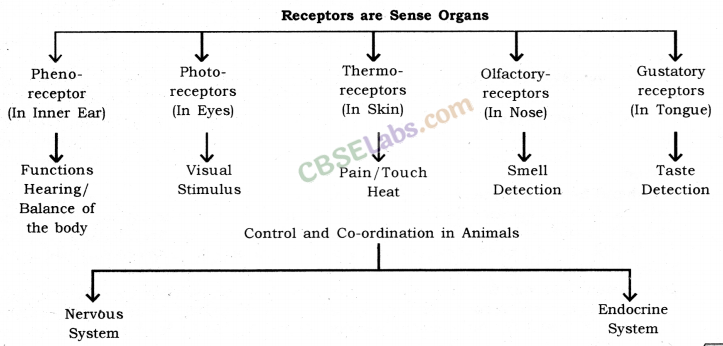
Nervous System: The nervous system is composed of specialized tissues, called nervous tissue. The nerve cell or neuron is the functional unit of the nervous system. It is the nervous system which is mainly responsible for control and coordination in complex animals.
Functions of the nervous system
- Nervous system receives information from the environment.
- To receive the information from the various body.
- To act according to through muscles and glands.
A neuron is the structural and functional unit of the nervous system.
Neuron: Neuron is a highly specialized cell which is responsible for the transmission of nerve impulses. The neuron consists of the following parts
(i) Cyton or cell body: The cell body or cyton is somewhat star-shaped, with many hair like structures protruding out of the margin. These hair-like structures are called dendrites. Dendrites receive the nerve impulses.
(ii) Axon: This is the tail of the neuron. It ends in several hair-like structures, called axon terminals. The axon terminals relay nerve impulses.
(iii) Myelin sheath: There is an insulator cover around the axon. This is called myelin sheath. The myelin sheath insulates the axon against nerve impulse from the surroundings.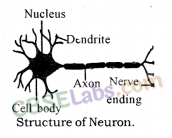
Types of neuron
- Sensory neuron: These neurons receive signals from a sense organ.
- Motor neuron: These neurons send signals to a muscle or a gland.
- Association or relay neuron: These neurons relay the signals between sensory neuron and motor neuron.
Synapse: The point contact between the terminal branches of axon of one neuron with the dendrite of another neuron is called synapse.
Neuromuscular Junction (NMJ): NMJ is the point where a muscle fibre comes in contact with a motor neuron carrying nerve impulse from the control nervous system.
Transmission of nerve impulse: Nerve impulses travel in the following manner from one neutron to the next :
Dendrites → cell body → axon → nerve endings at the tip of axon → synapse → dendrite of next neuron.
Chemical released from axon tip of one neuron, cross the synapse or neuromuscular junction to reach the next cell.
Human Nervous System: The nervous system in humans can be divided into three main parts
1. Central Nervous System: The central nervous system is composed of the brain and the spinal cord. The brain controls all the functions in the human body. The spinal cord works as the relay channel for signals between the brain and the peripheral nervous system.
2. Peripheral Nervous System: The peripheral nervous system is composed of the cranial nerves and spinal nerves. There are 12 pairs of cranial nerves. The cranial nerves come our of the brain and go to the organs in the head region. There are 31 pairs of spinal nerves. The spinal nerves come out of the spinal cord and go to the organs which are below the head region.
3. Autonomous Nervous System: The autonomous nervous system is composed of a chain of nerve ganglion which runs along the spinal cord. It controls all the involuntary actions in the human body. The autonomous nervous system can be divided into two parts :
- Sympathetic nervous system.
- Parasympathetic nervous system.
Sympathetic Nervous System: This part of the autonomous nervous system heightens the activity of an organ as per the need. For example, during running, there is an increased demand for oxygen by the body. This is fulfilled by an increased breathing rate and increased heart rate. The sympathetic nervous system works to increase the breathing rate the heart rate, in this case.
Parasympathetic Nervous System: This part of the autonomous nervous system slows the down the activity of an organ and thus has a calming effect. During sleep, the breathing rate slows down and so does the heart rate. This is facilitated by the parasympathetic nervous system. It can be said that the parasympathetic nervous system helps in the conservation of energy.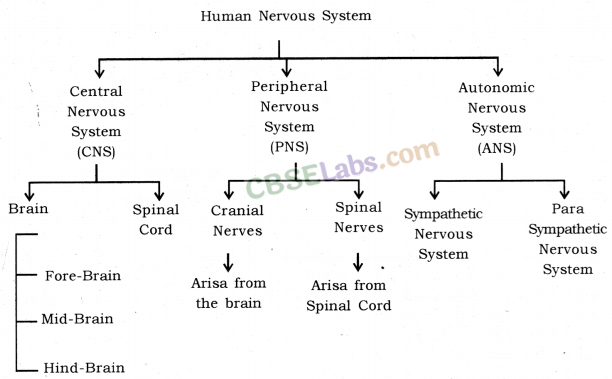
Human Brain: Human brain is a highly complex organ, which is mainly composed of nervous tissue. The tissues are highly folded to accommodate a large surface area in less space. The brain is covered by a three-layered system of membranes, called meninges. Cerebrospinal fluid is filled between the meninges. The CSF providers cushion the brain against mechanical shocks. Furthermore, protection. The human brain can be divided into three regions, viz. forebrain, midbrain and hindbrain.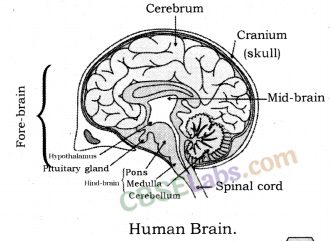
Parts of Human Brain :
- Fore-brain: It is composed of the cerebrum.
- Mid-brain: It is composed of the hypothalamus.
- Hind-brain: It is composed of the cerebellum, pons, medulla, oblongata.
Some main structures of the human brain are explained below :
Cerebrum: The cerebrum is the largest part in the human brains. It is divided into two hemispheres called cerebral hemispheres.
Functions of cerebrum
- The cerebrum controls voluntary motor actions.
- It is the site of sensory perceptions, like tactile and auditory perceptions.
- It is the seat of learning and memory.
Hypothalamus: The hypothalamus lies at the base of the cerebrum. It controls sleep and wake cycle (circadian rhythm) of the body. It also controls the urges for eating and drinking.
Cerebellum: Cerebellum lies below the cerebrum and at the back of the whole structure. It coordinates the motor functions. When you are riding your bicycle, the perfect coordination between your pedalling and steering control is achieved by the cerebellum.
- It controls posture and balance.
- It controls the precision of voluntary action.
Medulla: Medulla forms the brain stem, along with the pons. It lies at the base of the brain and continues into the spinal cord. The medulla controls various involuntary functions, like hear beat respiration, etc.
It controls involuntary actions.
Example: Blood pressure, salivation, vomiting.
Pons: It relays impulses between the lower cerebellum and spinal cord, and higher parts of the brain like the cerebrum and midbrain, also regulates respiration.
Spinal cord: Spinal cord controls the reflex actions and conducts massages between different parts of the body and brain.
Reflex Action: Reflex action is a special case of involuntary movement involuntary organs. When a voluntary organ is in the vicinity of sudden danger, it is immediately pulled away from the danger to save itself. For example, when your hand touches a very hot electric iron, you move away your hand in a jerk. All of this happens in flash and your hand is saved from the imminent injury. This is an example of reflex action.
Reflex Arc: The path through which nerves signals, involved in a reflex action, travel is called the reflex arc. The following flow chart shows the flow of signal in a reflex arc.
Receptor → Sensory neuron → Relay neuron → Motor neuron → Effector (muscle)
The receptor is the organ which comes in the danger zone. The sensory neurons pick signals from the receptor and send them to the relay neuron. The relay neuron is present in the spinal cord. The spinal cord sends signals to the effector via the motor neuron. The effector comes in action, moves the receptor away from the danger.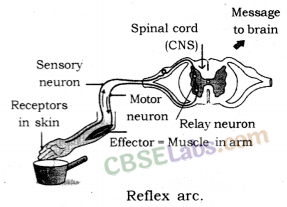
The reflex arc passes at the level of the spinal cord and the signals involved in reflex action do not travel up to the brain. This is important because sending signals to the brain would involve more time.
Although every action is ultimately controlled by the brain, the reflex action is mainly controlled at the level of spinal cord.
Protection of brain and spinal cord
Brain is protected by a fluid filled balloon which acts as shocks absorber and enclosed in cranium (Brain box)
Spinal chord is enclosed in vertebral column.
Muscular Movements and Nervous Control: Muscle tissues have special filaments, called actin and myosin. When a muscle receives a nerve signal, a series of events is triggered in the muscle. Calcium ions enter the muscle cells. It result in actin and myosin filaments sliding towards each other and that is how a muscle contracts. Contraction in a muscle brings movement in the related organ.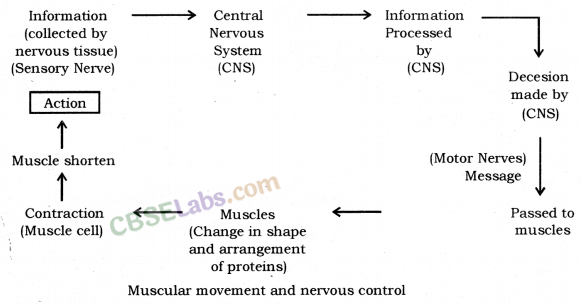
Endocrine System: The endocrine system is composed of several endocrine glands. A ductless gland is called endocrine gland. Endocrine gland secretes its product directly into the bloodstream. Hormones are produced in the endocrine glands. Hormone is mainly composed of protein. Hormones assist the nervous system in control and co-ordination. Nervous do not react to every nook and corner of the body and hence hormones are needed to affect control and coordination in those parts. Moreover, unlike nervous control, hormonal control is somewhat slower.
Hormones: These are the chemical messengers secreted in very small amounts by specialised tissues called ductless glands. They act on target tissues/organs usually away from their source. Endocrine System helps in control and coordination through chemical compounds called hormones.
Endocrine Gland: A ductless gland that secretes hormones directly into the bloodstream.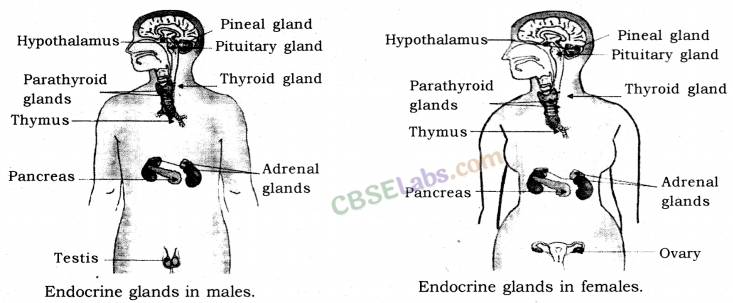
Endocrine Gland | Location | Hormones Produced | Functions |
| Pituitary gland (also known as the master gland) | At the base of the brain | Growth hormone (GH). Thyroid stimulating hormone (TSH). Follicle stimulating hormone (FSH) | GH stimulates growth. TSH stimulates the functioning of the thyroid gland. FSH stimulates the follicles during ovulation. |
| Thyroid Gland | Neck | Thyroxine | Controls general metabolism and growth in the body. |
| Adrenal gland | Above kidneys | Adrenalin | Prepares the body for emergency situations and hence is also called ‘Fight and flight’ hormone. |
| Pancreas | Near stomach | Insulin | Controls blood sugar level |
| Testis (male) | In Scrotum | Testosterone | Sperm production, development of secondary sexual characters during puberty. |
| Ovary (female) | Near uterus | Oestrogen | Egg production, development of secondary sexual characters during puberty. |
Iodised salt is necessary because: Iodine mineral is essential part of thyronine hormone so it is important that we must consume iodised salt as in turn it is essential for thyroid gland as it controls carbohydrate, proteins and fat metabolism for best balance of growth deficiency of iodine might cause disease called goitre.
Diabetes: Cause : It is due to deficiency of insulin hormone secreted by pancreas that is responsible to lower/control the blood sugar levels.
Treatment : Patients have to internally administer injections of insulin hormone which helps in regulating blood-sugar level.
In case of flight or fight reaction to an emergency situation, Adrenal glands → release adrenaline into blood → which acts on heart and other tissues → causes faster heart beat → more oxygen to muscles → reduced blood supply to digestive system and skin → diversion of blood to skeletal muscles → increase in breathing rate.
Feedback mechanism: A type of self-regulating mechanism in which the level of one substance in body influences the level of another.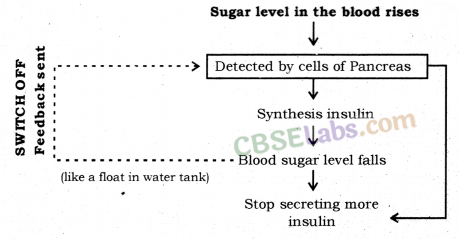
Control and Co-ordination in Plants: Movements in plants and plant harmones.
Co-ordination in Plants: Unlike animals, plants do not have a nervous system. Plants use chemical means for control and co-ordination. Many plant hormones are responsible for various kinds of movements in plants. Movements in plants can be divided into two main types :
- Tropic movement
- Nastic movement
1. Tropic Movement: The movements which are in a particular direction in relation to the stimulus are called tropic movements. Tropic movements happen as a result of growth of a plant part in a particular direction. There are four types of tropic movements.
(i) Geotropic movement: The growth in a plant part in response to the gravity is called geotropic movement. Roots usually show positive geotropic movement, i.e. they grow in the direction of the gravity. Stems usually show negative geotropic movement.
(ii) Phototropic Movement: The growth in a plant part in response to light is called phototropic movement. Stems usually show positive phototropic movement, while roots usually show negative phototropic movement. If a plant is kept in a container in which no sunlight reaches and a hole in the container allows some sunlight; the stem finally grows in the direction of the sunlight. This happens because of a higher rate of cell division in the part of stem which is away from the sunlight. As a result, the stem bends towards the light. The heightened rate of cell division is attained by increased secretion of the plant hormone auxin in the which is away from sunlight.
(iii) Hydrotropic Movement: When roots grow in the soil, they usually grow towards the nearest source of water. This shows a positive hydrotropic movement.
(iv) Thigmotropism Movement: The growth in a plant part in response to touch is called thigmotropism movement. Such movements are seen in tendrils of climbers. The tendril grows in a way so as it can coil around a support. The differential rate of cell division in different parts of the tendril happens due to action of auxin.
2. Nastic Movement: The movement which do not depend on the direction from the stimulus acts are called nastic movement. For example, when someone touches the leaves of mimosa, the leaves droop. The drooping is independent of the direction from which the leaves are touched. Such movements usually happen because of changing water balance in the cells. When leaves of mimosa are touched, the cells in the leaves lose- water and become flaccid, resulting in drooping of leaves.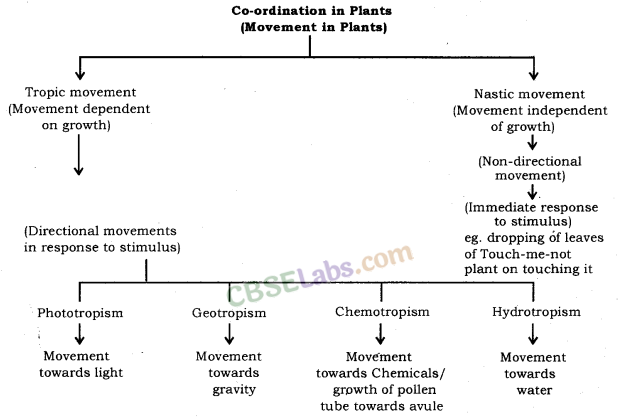
Plant hormones: Plant hormones are chemical which help to co-ordinate growth, development and responses to the environment.
Type of plant hormones: Main plant hormones are
- Auxin: (Synthesized at shoot tip).
Function: Helps in growth.
Phototropism: more growth of cells towards the light. - Gibberellin: Helps in the growth of the stem.
- Cytokinins: Promotes cell division.
- Abscisic acid: Inhibits growth, cause wilting of leaves. (Stress hormone)
Control and Coordination in Plants
- Stimuli: The change in the environment to which an organism responds.
- Co-ordination: Working together of various organs of an organism in a systematic manner to produce a proper response.
- Phyto-hormones: These are plant hormones.
- Auxin: It is a plant hormone which promotes cell enlargement and growth in plants.
- Gibberellins: A plant hormone which promotes cell differentiation and breaking dormancy of seeds and buds.
- Cytokinin: A plant hormone which promotes cell division and the opening of stomata.
- Abscisic Acid: It helps in inhibiting the growth of the plant and promotes wilting and falling of leaves and food.
- Tropism: A growth movement of a plant which determines direction with the stimulus.
- Nastism: A growth movement of a plant which does not determine direction with a stimulus.
- Phototropism: Movement of plants towards a light.
- Geotropism: Movement of plants towards the gravity of earth.
- Chemotropism: Movement of plants towards chemicals.
- Hydrotropism: Movement of plants towards the water.
- Thigmotropism: Movement of plants towards a response to the touch of an object.
Control and Coordination in Animals
- Stimuli: The change in the environment to which the organism responds.
- Co-ordination: Working together of various organs of an organism in a systematic manner to produce a proper response.
- Neuron: Functional unit of the nervous system.
- Synapse: A microscopic gap between a pair of adjacent neurons.
- Receptor: A cell in a sense organ which is sensitive to stimuli.
- Motor nerves: It carries the message from the brain to body parts for action.
- Sensory nerves: It carries the message from body to brain.
- Olfactory receptor: It detects smell by the nose.
- Gustatory receptor: It detects taste by a tongue.
- Thermoreceptor: It detects heat and cold by a skin.
- Photoreceptor: It detects light by eye.
- Reflex action: Sudden movement or response to the stimulus which occurs in a very short duration of time and does not involve any will or thinking of the brain.
- Brain: An organ present in the skull which controls and regulates the activity of the whole body and is known as president of the body.
- Cerebrum: Main thinking part of brain present in the forebrain area which controls all voluntary actions.
- Cerebellum: It is present in the hindbrain area and helps in maintaining posture and balance of the body.
- Medulla: It is present in the hindbrain area and helps in controlling voluntary actions of the brain.
- Spinal cord: It is a cylindrical structure of nerve fibres enclosed in the vertebral column which helps in the conduction of nerve impulses to and from the brain.
NCERT Exemplar Class 10 Science Chapter 7 Control And Coordination
Short Answer Type Questions
1.Label the parts (a), (b), (c) and (d) and show the direction of flow of electrical signals in the given figure.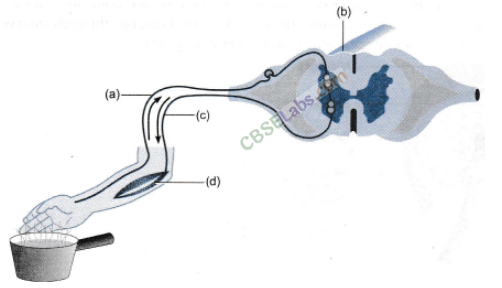
Answer.
(a) Sensory neuron.
(b) Spinal cord (CNS).
(c) Motor neuron.
(d) Effector (Muscle in arm).
2.Name the plant hormones responsible for the following:
(а) Elongation of cells.
(b) Growth of stem.
(c) Promotion of cell division.
(d) Falling of senescent leaves.
Answer.(a) Auxin. (b) Gibberellin. (c) Cytokinin. (d) Abscisic acid.
3.Label the endocrine glands in the given figure.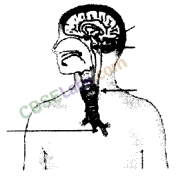
Answer.(a) Pineal gland. (b) Pituitary gland, (c) Thyroid, (d) Thymus.
4 What is a tropic movement? Explain with an example.
Answer.The directional growth movements of plants due to external stimuli are called tropic movement. It can be either towards the stimulus, or away from it. For example, in case of phototropic movement, shoots respond by bending towards light while roots respond by bending away from it.
5.What will happen if intake of iodine in our diet is low?
Answer.When iodine intake is low, release of thyroxin from thyroid gland will be less by which protein, carbohydrate and fat metabolisms will be affected.
A person might suffer from goitre in case of iodine deficiency in the body,
6.Answer the following:
(а) Which hormone is responsible for the changes noticed in females at puberty?
(b) Dwarfism results due to deficiency of which hormone?
(c) Blood sugar level rises due to deficiency of which hormone?
(d) Iodine is necessary for the synthesis of which hormone?
Answer.(a) Oestrogen. (b) Growth hormone. (c) Insulin. (d) Thyroxin.
7.Answer the following:
(a) Name the endocrine gland associated with brain?
(b) Which gland secretes digestive enzymes as well as hormones?
(c) Name the endocrine gland associated with kidneys?
(d) Which endocrine gland is present in males but not in females?
Answer.(a) Pituitary. (b) Pancreas, (c) Adrenal. (d) Testes.
Long Answer Type Questions
8.What are the major parts of the brain? Mention the functions of different parts.
Answer.
• Forebrain: It is composed of the cerebrum.
• Midbrain: It is composed of the hypothalamus.
• Hindbrain: It is composed of the cerebellum, pons and medulla oblongata.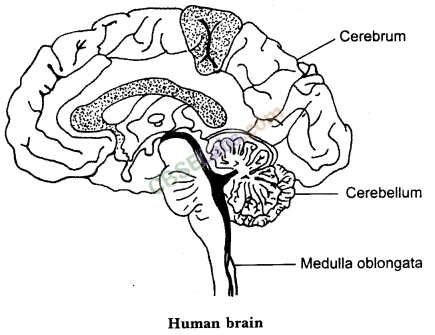
Some main structures of the human brain are explained below.
(i) Cerebrum: The cerebrum is the largest part in the human brain. It is divided into two hemispheres; called cerebral hemispheres.
Functions of cerebrum:
(a) The cerebrum controls the voluntary motor actions.
(b) It is the site of sensory perceptions; like tactile and auditory perceptions.
(c) It is the seat of learning and memory.
(ii) Hypothalamus: The hypothalamus lies at the base of the cerebrum. It controls sleep and wake cycle (circadian rhythm) of the body. It also controls the urges for eating and drinking.
(iii) Cerebellum: Cerebellum lies below the cerebrum and at the back of the whole structure. It coordinates the motor functions. When you are riding your bicycle; the perfect coordination between pedaling and steering control is achieved by the cerebellum.
(iv) Medulla: Medulla forms the brain stem; along with the pons. It lies at the base of the brain and continues into the spinal cord. Medulla controls various involuntary functions; like heart beat, respiration, etc.
9.Mention one function for each of these hormones:
(a) Thyroxin (b) Insulin (c) Adrenaline (d) Growth hormone (e) Testosterone.
Answer. (a) Thyroxin regulates carbohydrate, fat and protein metabolisms.
(b) Insulin regulates blood sugar.
(c) Adrenaline increases heart rate and supply of blood to various organs.
(d) Growth hormone regulates growth and development.
(e) Testosterone controls the changes of body features associated with puberty in male.
10. Name various plant hormones. Also give their physiological effects on plant growth and development.
Answer. The various plant hormones are Auxin, Gibberellin,Cytokinin, and Abscisic acid. Their physiological effects on plant growth are as follows:
Auxins: Cell elongation, cell division, root formation, apical dominance, inhibition of abscission and fruit growth.
Gibberellins: Growth in stem and leaves, higher fruit yield and over coming dormancy.
Cytokines: Promotes cell division, differentiation, prevention of senescence and overcoming apical dominance .
Absciscic acid: Induces dormancy, senescence, abscission, checking excessive activity of growth promoting hormone and closure of stomata under water stress. .
11. Why is the flow of signals in a synapse from axonal end of one neuron to dendritic end of another neuron but not the reverse?
Answer. When an electrical signal reaches the axonal end of a neuron, it releases a chemical substance. This chemical diffuses towards the dendrite end of next neuron where it generates an electrical impulse or signal. Hence, the electrical signal is converted into a chemical signal at the axonal end. Since these chemicals are absent at the dendrite end of the neuron the electrical signal, cannot be converted into chemical signal.
Extra Questions – Control and Coordination – CBSE Class 10 Science
According to new CBSE Exam Pattern, MCQ Questions for Class 10 Science pdf Carries 20 Marks.
Topics and Subtopics in NCERT Solutions for Class 10 Science Chapter 7 Control and Coordination:
Question-1
What is a neuron?
Solution:
A neuron is a nerve cell that is the basic building block of the nervous system. Neurons are similar to other cells in the human body in a number of ways, but there is one key difference between neurons and other cells. Neurons are specialized to transmit information throughout the body.
These highly specialized nerve cells are responsible for communicating information in both chemical and electrical forms. There are also several different types of neurons responsible for different tasks in the human body.
Question-2
Name any two types of tropism.
Solution:
The two types of tropism are phototropism and geotropism.
Question-3
What is a phytohormone? Name any two phytohormones.
Solution:
Phytohormones are chemical substances, which are produced naturally in plants and are capable of translocation and regulating one or more physiological reactions when present in appropriate concentrations. The two phytohormones are auxins and gibberellins.
Question-4
Mention the receptors for light and sound in animals.
Solution:
Photoreceptor is the receptor for light and phonoreceptor is the receptor for sound in animals.
Question-5
How does control and coordination takes place in plants?
Solution:
Plants have a unique mechanism of controlling and coordinating its various physiological and biological processes. Plants respond to light, touch, gravitational force and other stimuli. Growth and movements in plants are regulated by both external and internal factors. The functions of control and coordination in plants are performed by chemical substances known as plant hormones or phytohormones.
Question-6
Mention the names of various phytohormones.
Solution:
The various phytohormones are auxins, gibberellins, cytokines, abscises acid and ethylene.
Question-7
Discuss phototropism.
Solution:
The movement of plants toward light is called phototropism.
Question-8
Differentiate between tropic and nastic movements.
Solution:
Tropic movement:
The movement of a plant in the direction of stimulus.
Nastic movement:
The movements, which are neither towards nor away from the stimulus.
Question-9
Draw the diagram of a neuron.
Solution:
Question-10
Draw a neat diagram of the nervous system in an insect.
Solution:
Question-11
Describe the central nervous system in human beings.
Solution:
The central nervous system in human beings is highly developed. It consists of
(i) brain and (ii) spinal cord. Brain is the highest coordinating centre in the body. It is protected by a bony box in the skull called the cranium. Brain is covered by three membranes, called meninges. The space between the membranes is filled by cerebrospinal fluid that protects the brain from mechanical shocks.
The brain is broadly divided into three regions
(i) Fore brain (ii) Mid brain and (iii) Hind brain.
Each region of the brain consists of various centers. The fore brain includes cerebrum and olfactory lobes.The cerebrum is the most complex and specialized part of the brain. It consists of two cerebral hemispheres.The cerebrum has sensory areas where information is received from sense organs. Similarly, there is the motor area from where impulses are sent to the muscle or effectors organs. In the cerebrum, specific regions for each kind of stimulus and its response are located. Pairs of cranial nerves arise from the brain. The hind brain consists of three centers, cerebellum, pons and medulla oblongata. Medulla oblongata is the regulating centre for swallowing, coughing, sneezing and vomiting. The pons takes part in regulation of respiration. Coordination and the adjustment of movement and posture are under the control of cerebellum.
Spinal cord is a part of the central nervous system, which lies in the vertebral canal. It is a downward continuation of the medulla oblongata. In the spinal cord, the arrangement of white and grey matter is reverse of that of the brain. The grey matter containing cytons is the inner region and white matter containing myelinated axons is the outer. In the centre of the spinal cord runs a small central canal. This central canal, which runs the entire length of the spinal cord, is continuous with the ventricles of the brain. The spinal cord in transverse section has H-shaped structure because it has fissures on the ventral and the dorsal sides. The dorsal fissure almost reaches the gray matter while the anterior median fissure falls short of it. Spinal cord gives off 31 pairs of nerves.
Question-12
Write the functions of any one part of the hind – brain.
Solution:
Cerebellum is the part of the hind – brain that controls and coordinates the movements of our body and helps in adjusting the posture. It functions even when the person is asleep.
Question-13
What is the autonomic nervous system?
Solution:
The autonomic nervous system controls the involuntary action of the body. It mainly controls and integrates the functions of internal organs like heart, blood vessels, glands, smooth muscles and uterus in the body. The autonomic nervous system is subdivided into (i) sympathetic and (ii) parasympathetic system. The organs receive nerves from both sympathetic and parasympathetic nerve fibers. They have antagonistic effects on the organs if one is stimulatory, the other is inhibitory.
Question-14
Define reflex action with suitable examples.
Solution:
When we suddenly withdraw our hands on pricking a pin, it is a reflex action. This type of sudden response to a stimulus is involuntary. A reflex action is defined as an unconscious and involuntary response of effectors to a stimulus. In reflex actions, a message from the receptors is relayed by sensory nerves to the spinal cord, which sends information for response via motor nerves to effectors. The pathway is called reflex arc. The simplest type of reflex action is knee-jerk reflex. In this case, while sitting with freely hanging legs, a strike below the knee cap kicks the leg forward. Other reflex actions are coughing, sneezing, yawning and blinking of eyes.
Question-15
Name the hormones secreted by thyroid, parathyroid and pancreas.
Solution:
(i) Thyroid secretes thyroxin,
(ii) Parathyroid secretes calcitonin and
(iii) Pancreas secrete insulin and glucagons.
Question-16
List the functions of testosterone and estrogen.
Solution:
The functions of testosterone are the regulation of male accessory sex organs and secondary sexual characters like moustache, beard and voice.
The functions of estrogen are the regulation of female accessory sex organs and secondary sexual characters like mammary glands, hair pattern and voice, and the maintenance of pregnancy.
Question-17
Write name of three hormones secreted by the pituitary gland.
Solution:
The three hormones secreted from pituitary gland are
(i) growth hormone, (ii) adrenocorticotrophic hormone and (iii) follicle stimulating hormone (FSH).
Question-18
Nervous and hormonal system together perform the function of control and coordination in human beings. Justify the statement.
Solution:
In humans, the nervous system is the most important, rather essential, system for regulation, control and coordination of body functions. It makes possible a range of adaptive responses to changes in the environment in the interests of the individuals. This system helps the individual to respond in a coordinated manner to environmental changes, to control various movements and to prolong the life by protecting the body against harmful stimuli. Coordination in humans is brought about by the secretions of endocrine glands. Endocrine glands are the ductless glands, which secrete the chemical substances called hormones directly into the blood. Any chemical substance, which is formed in the tissues of endocrine glands and are carried by the blood to other parts of the body for its specific actions is termed as a hormone. An organ, which responds to such a hormone, is known as the target organ. Hence, hormones and nervous system together perform the function of control and coordination in the human beings.
Question-19
What is hydrotropism?
Solution:
Hydrotropism is a type of tropism, where the plant shows movement in response to water.
Question-20
What is coordination?
Solution:
The organ system cannot work independently. They are linked in one way or the other. Working together of all these systems is called coordination.
Question-21
Why is the response of a plant to a stimulus not observed immediately?
Solution:
The response of a plant to a stimulus not observed immediately because the plant shows its response very slowly.
Question-22
What are hormones?
Solution:
Any chemical substance which is formed in the tissues of endocrine glands and are carried by the blood to other parts of the body for its specific actions is termed is hormone.
Question-23
What are phytohormones?
Solution:
A phytohormones can be defined as chemical substances, which are produced naturally in plants and are capable of translocation and regulating one or more physiological processes when present in low concentration.
Question-24
What are meanings? What are their functions? Name the fluid, which is filled in between meanings.
Solution:
The brain is surrounded by three membranes called meanings, which help to protect the brain. The space between the meanings is filled with cerebra spinal fluid, which protects the brain from mechanical shocks.
Question-25
How does control and coordination occur in single-celled animals?
Solution:
The cytoplasm of the single-celled animal controls and coordinates the activities of the organism.
Question-26
Name any two phytohormones, which are growth promoters.
Solution:
The two phytohormones, which are growth promoters are Auxins and Gibberellins.
Question-27
Name any growth inhibiting phytohormone.
Solution:
Abscises acid is a growth inhibiting phytohormone.
Question-28
What makes a stem bend towards sunlight?
Solution:
The chemical substance called plant hormone or phytohormone makes a stem bend towards sunlight.
NCERT Solutions for Class 10 Science All Subject NCERT Solutions
- Chapter 1 Chemical Reactions and Equations
- Chapter 2 Acids, Bases and Salts
- Chapter 3 Metals and Non-metals
- Chapter 4 Carbon and Its Compounds
- Chapter 5 Periodic Classification of Elements
- Chapter 6 Life Processes
- Chapter 7 Control and Coordination
- Chapter 8 How do Organisms Reproduce?
- Chapter 9 Heredity and Evolution
- Chapter 10 Light Reflection and Refraction
- Chapter 11 Human Eye and Colourful World
- Chapter 12 Electricity
- Chapter 13 Magnetic Effects of Electric Current
- Chapter 14 Sources of Energy
- Chapter 15 Our Environment
- Chapter 16 Management of Natural Resources
.png)
.png)